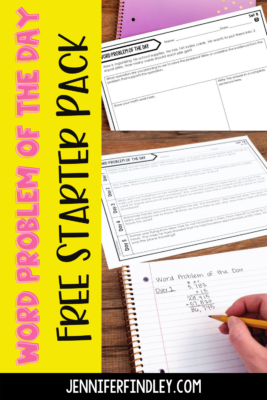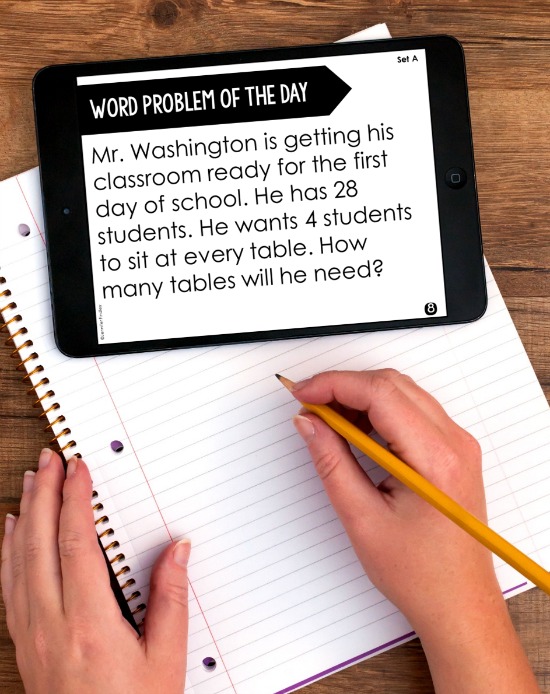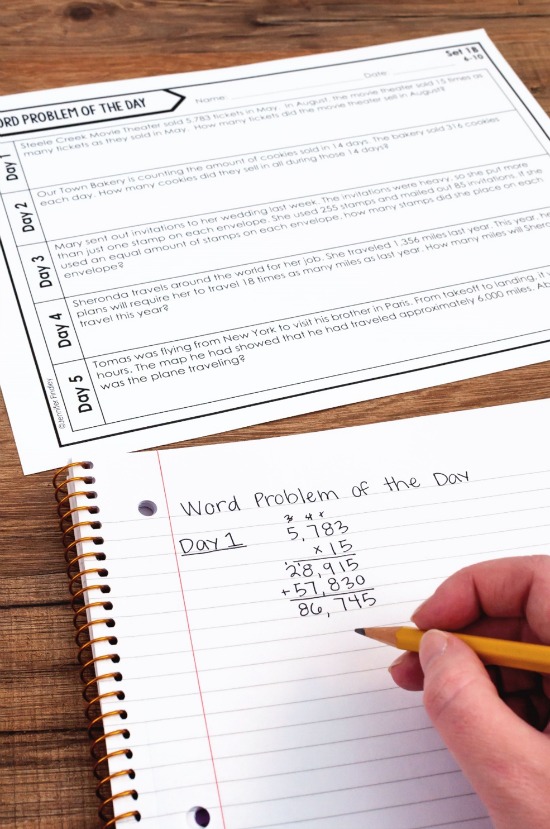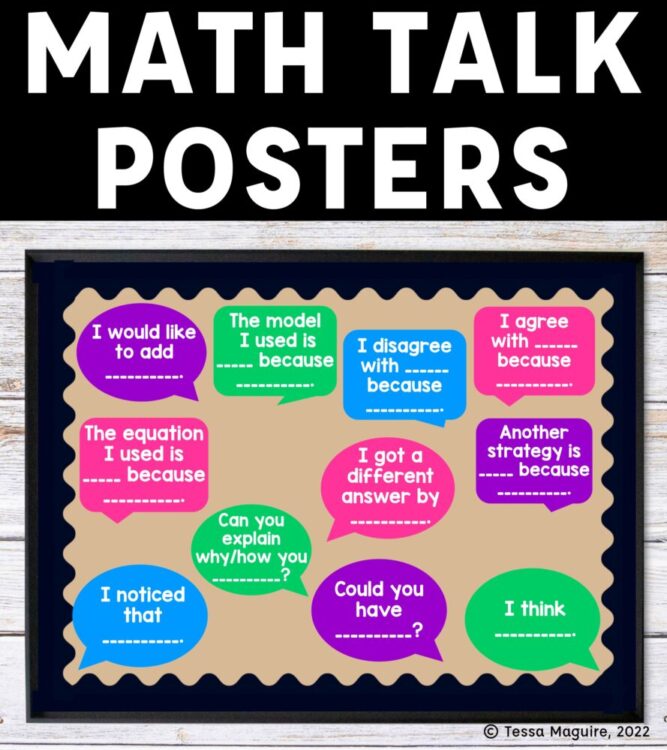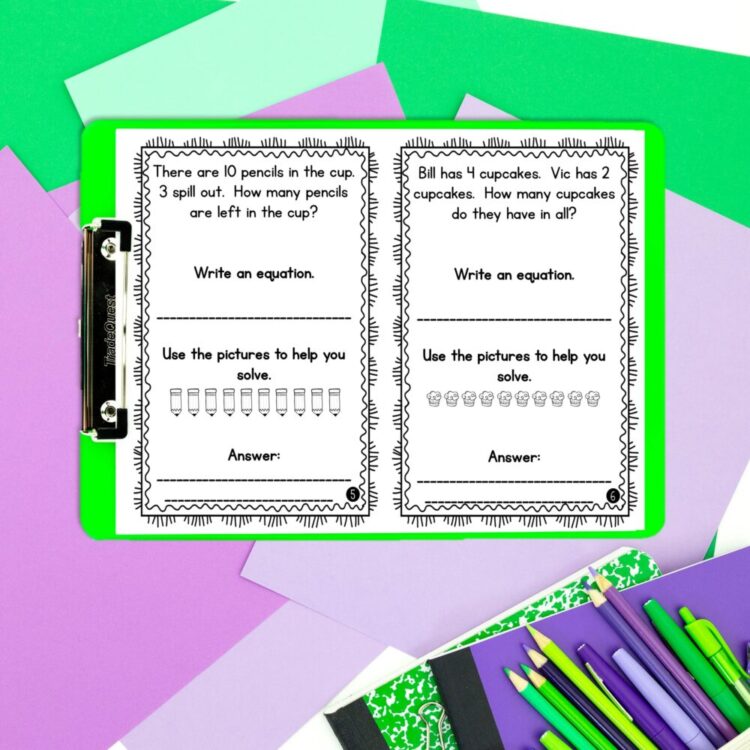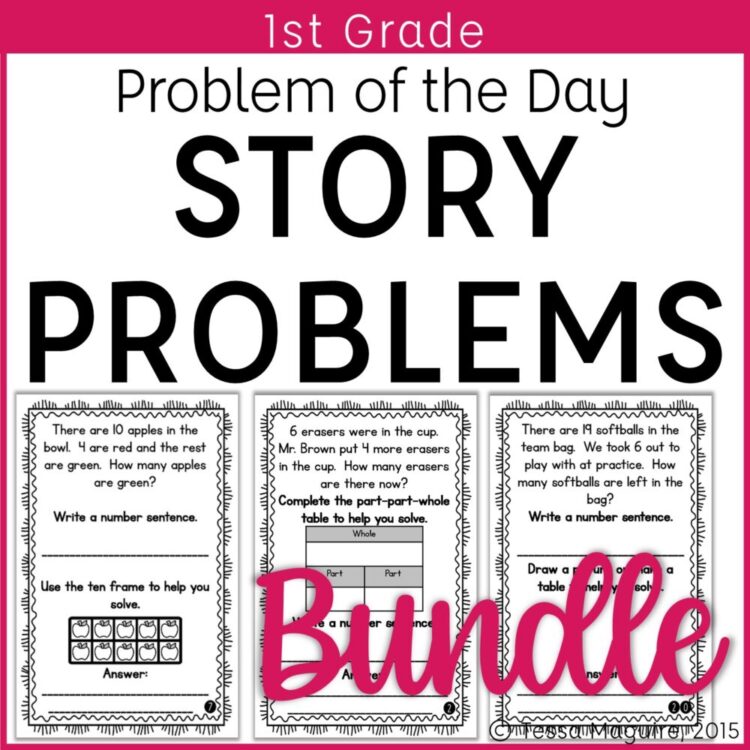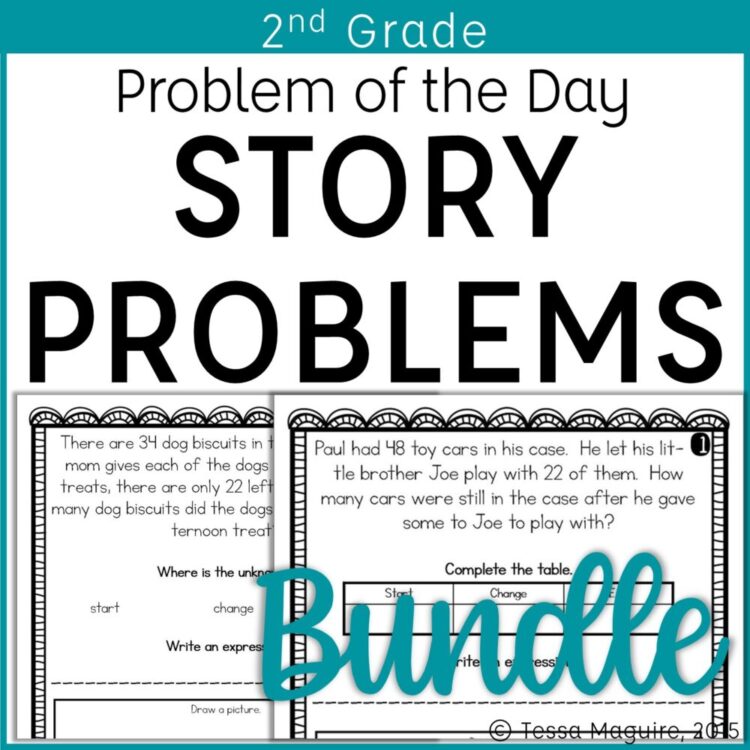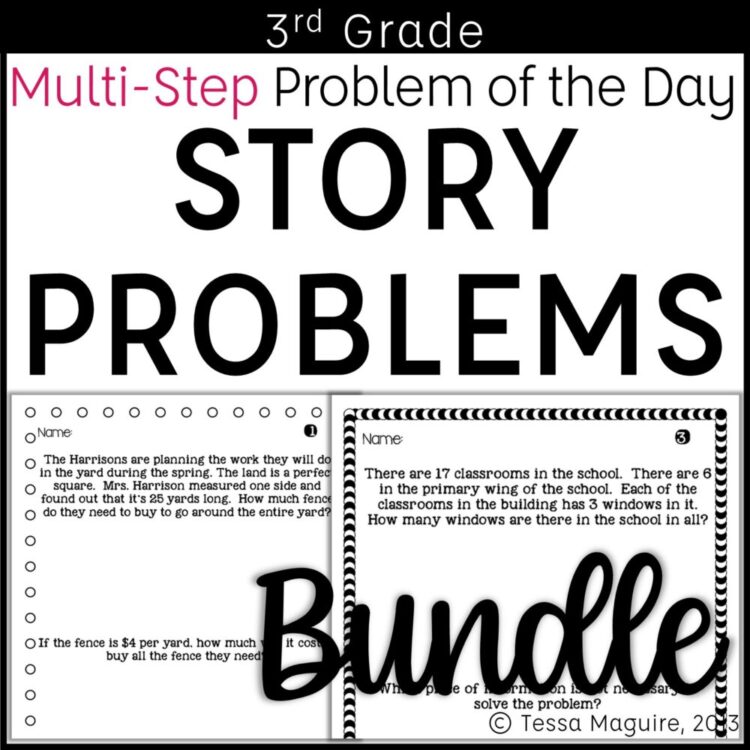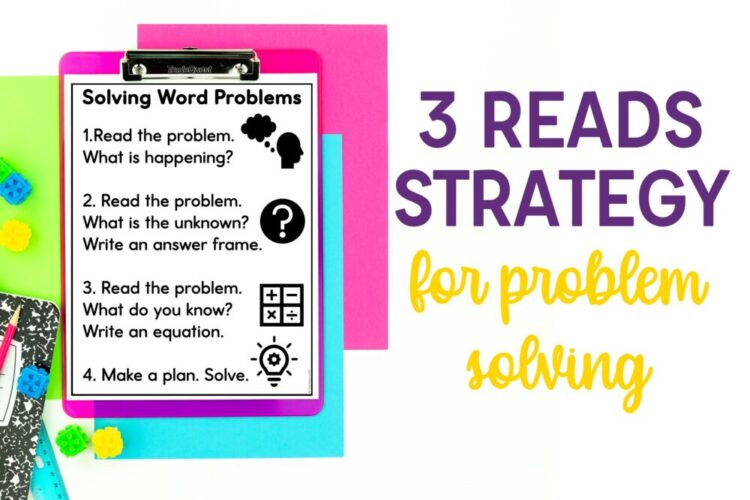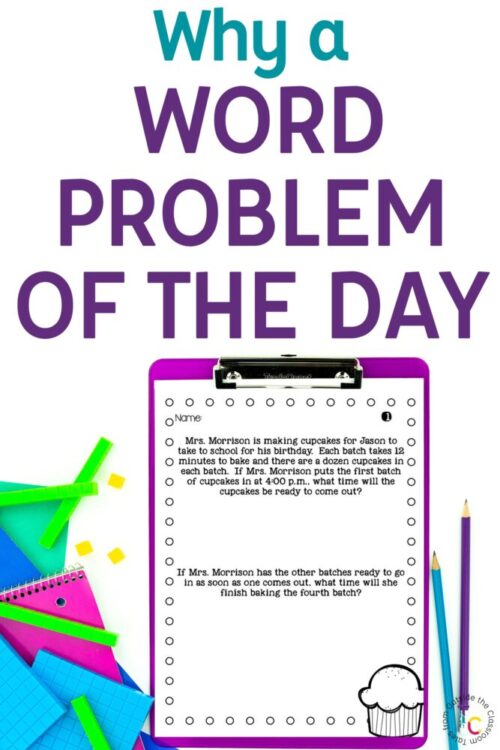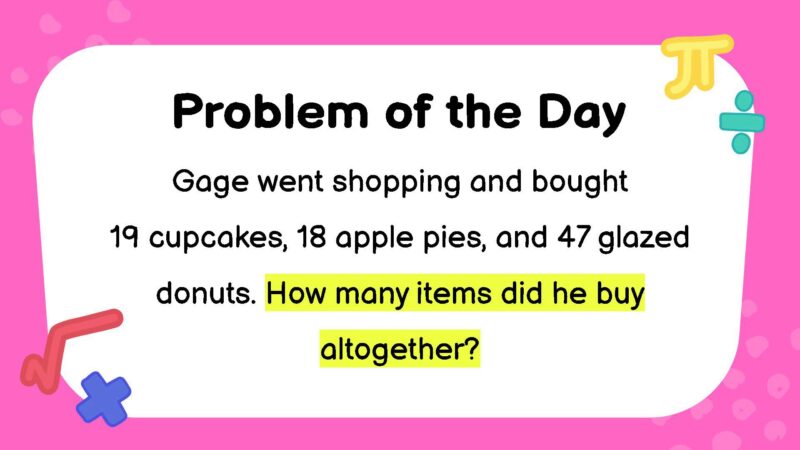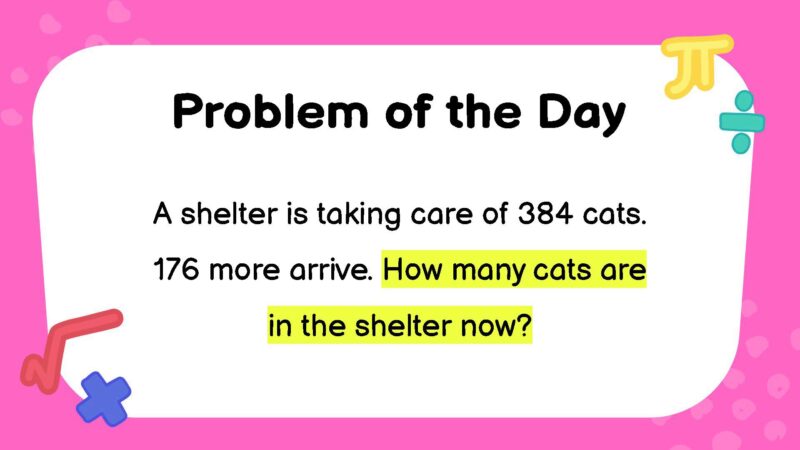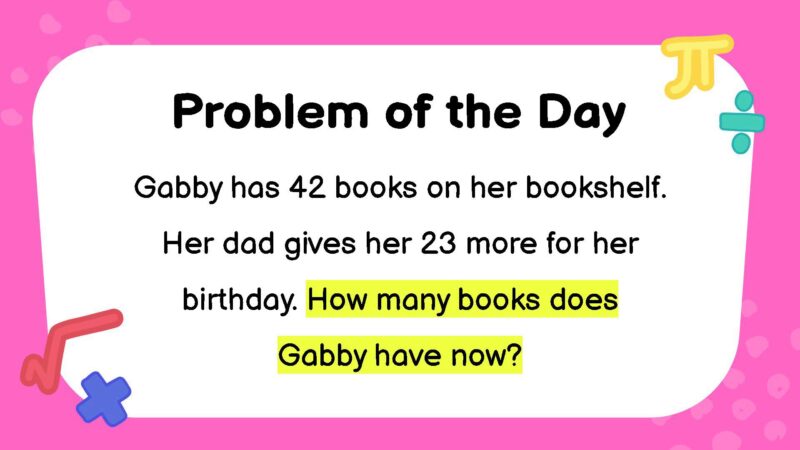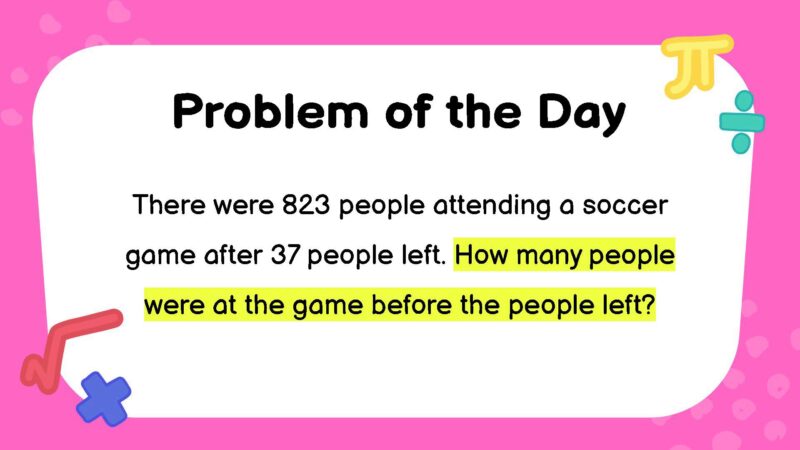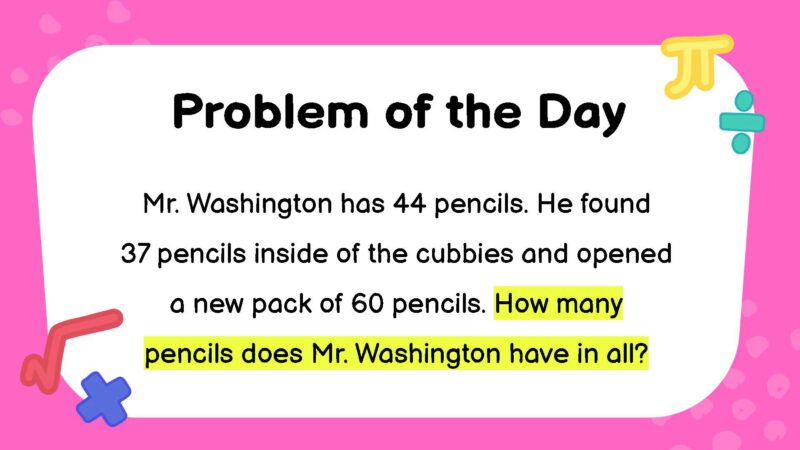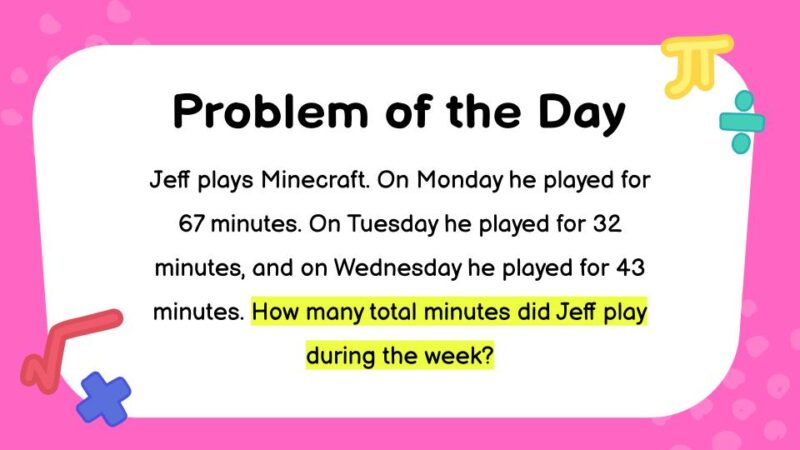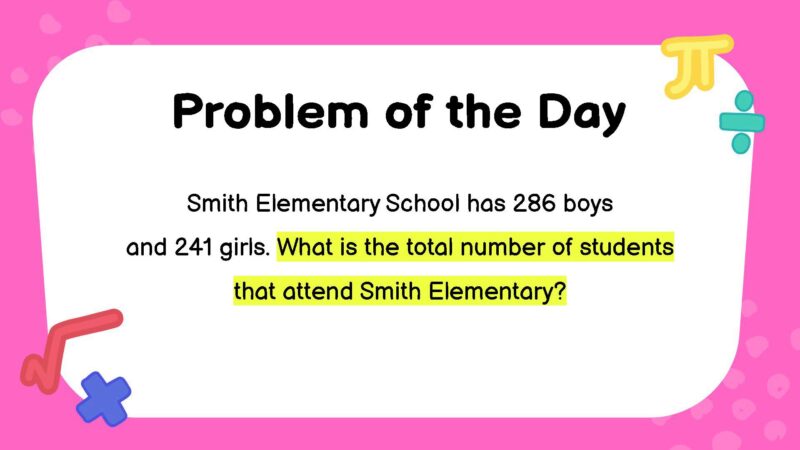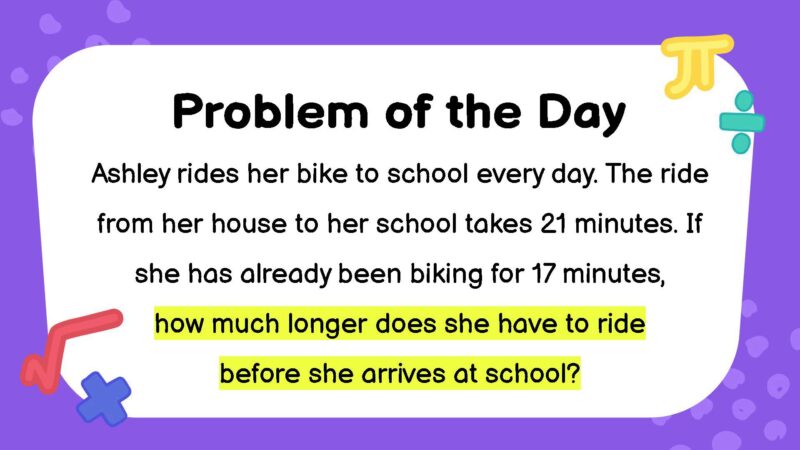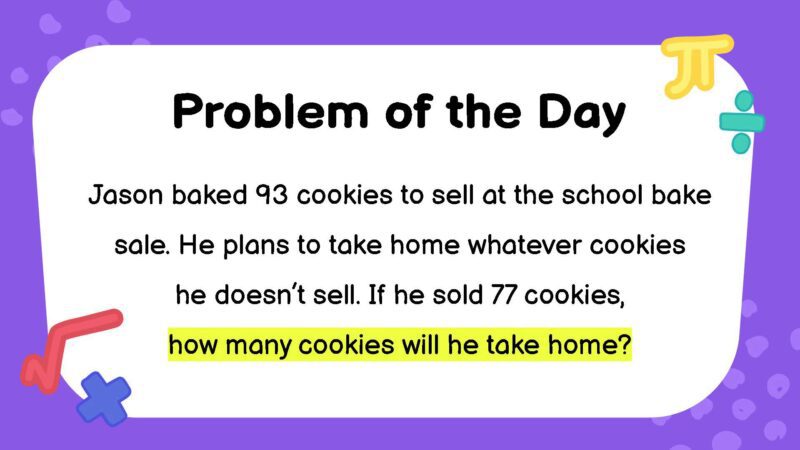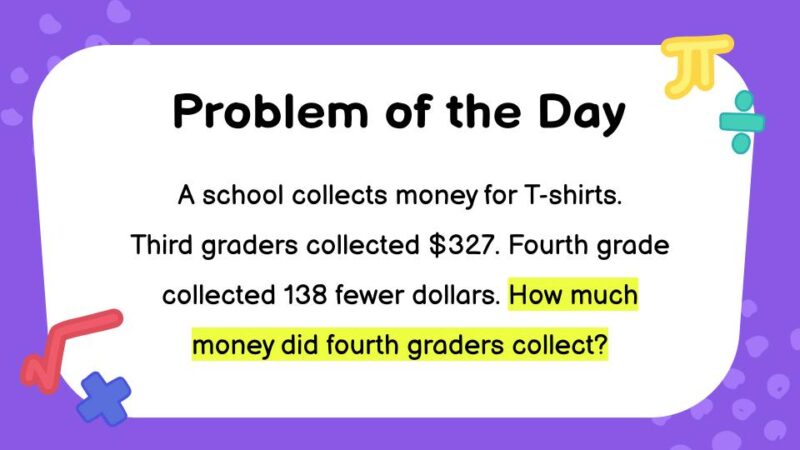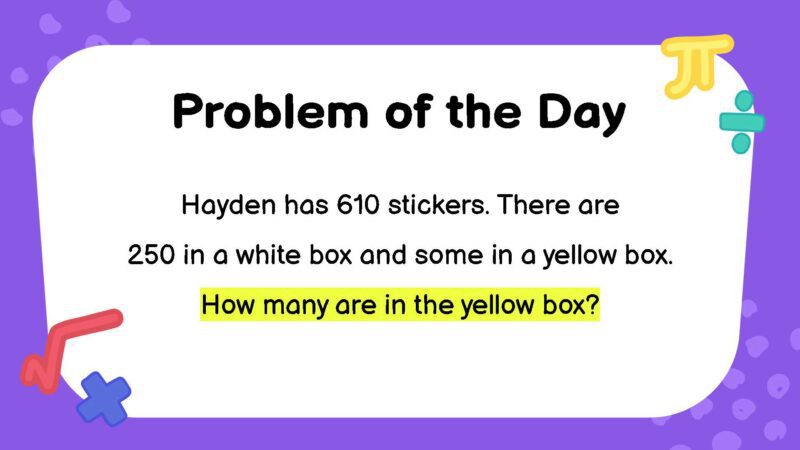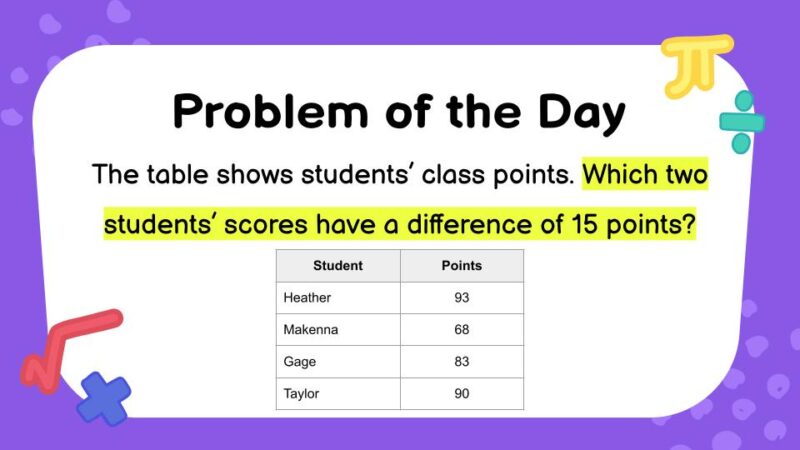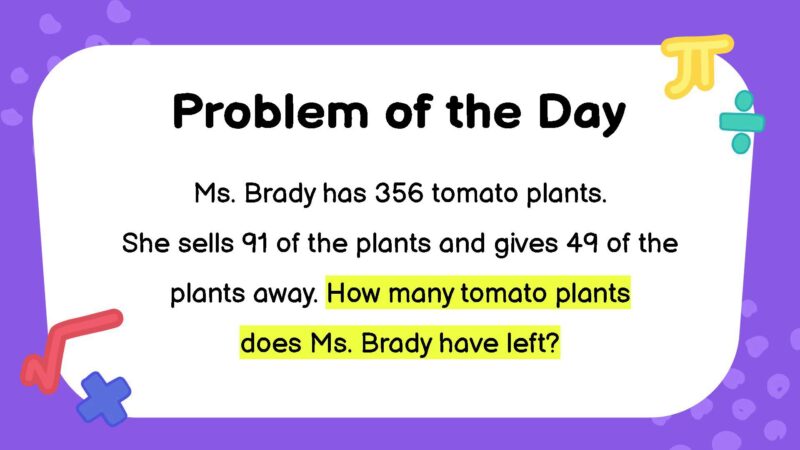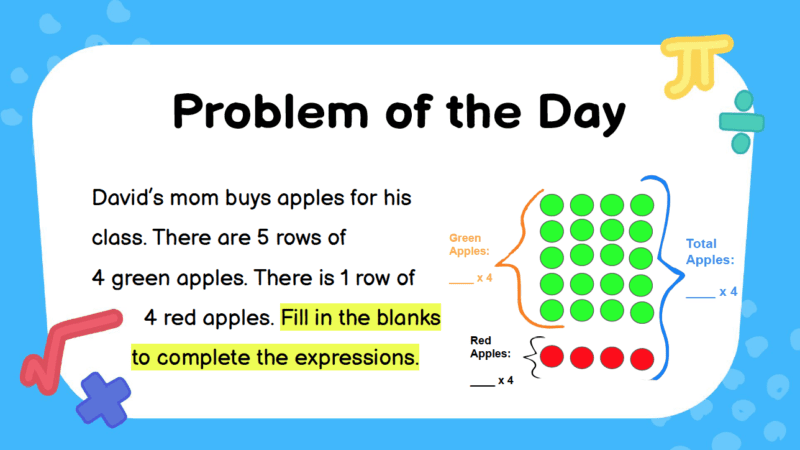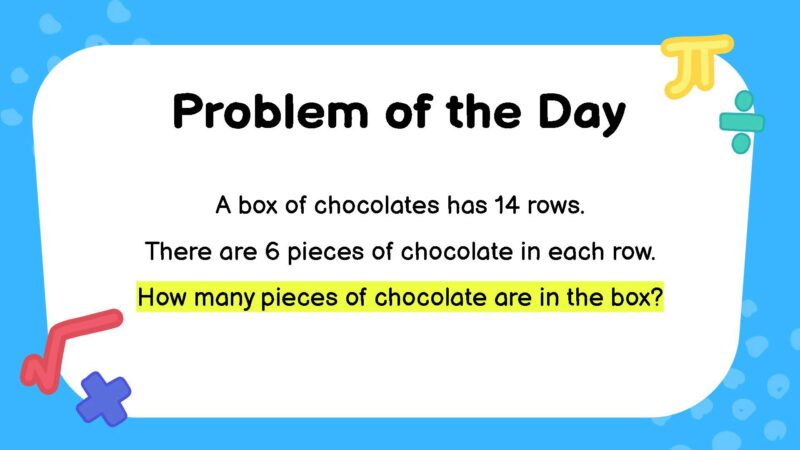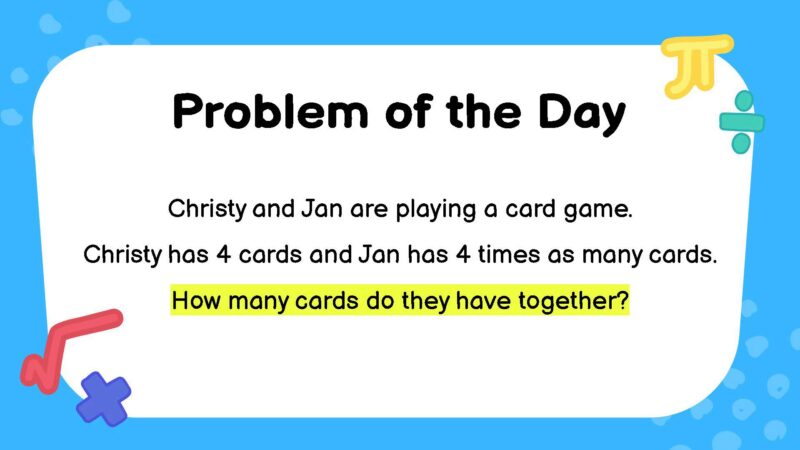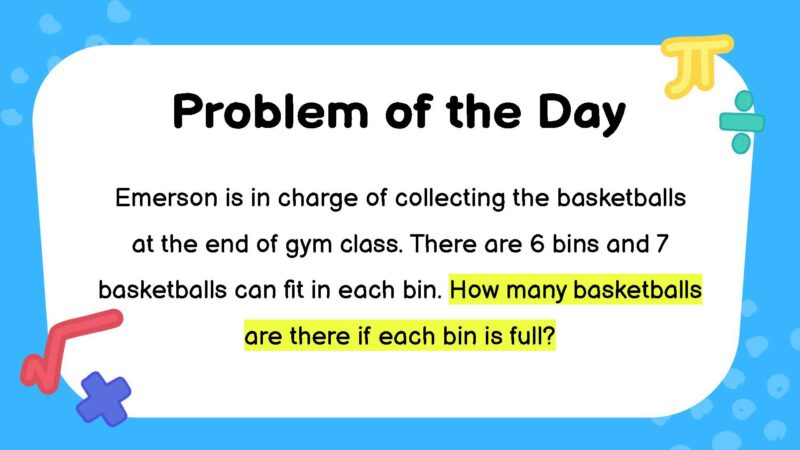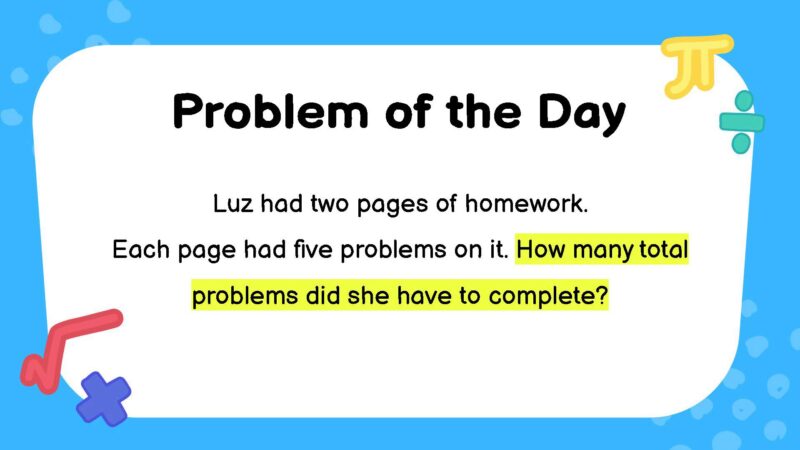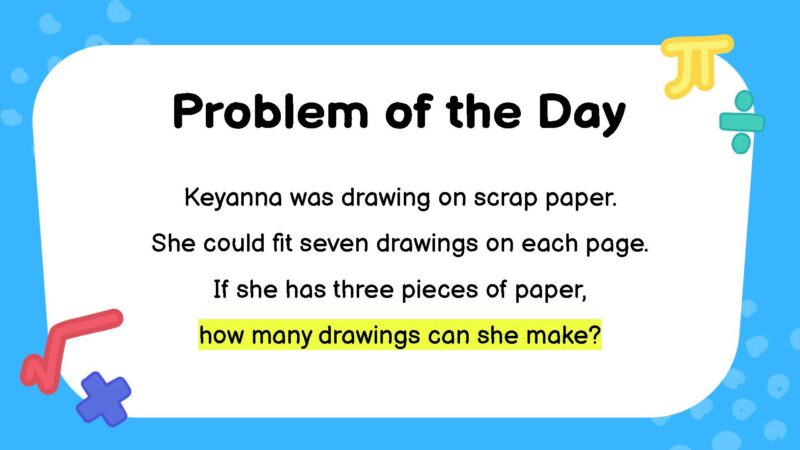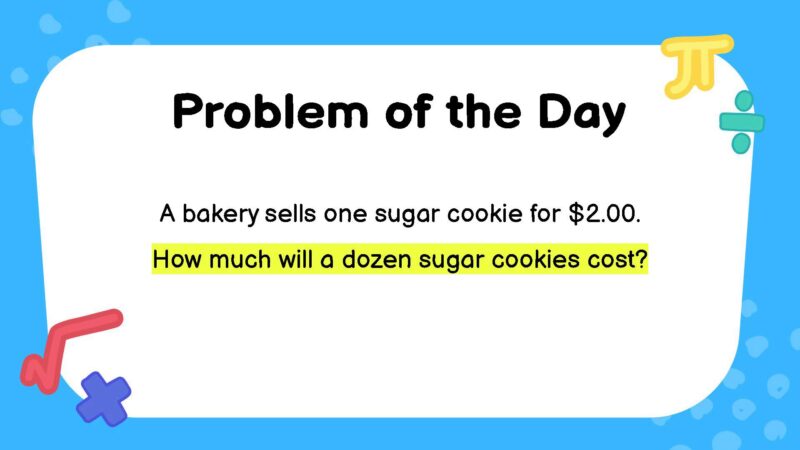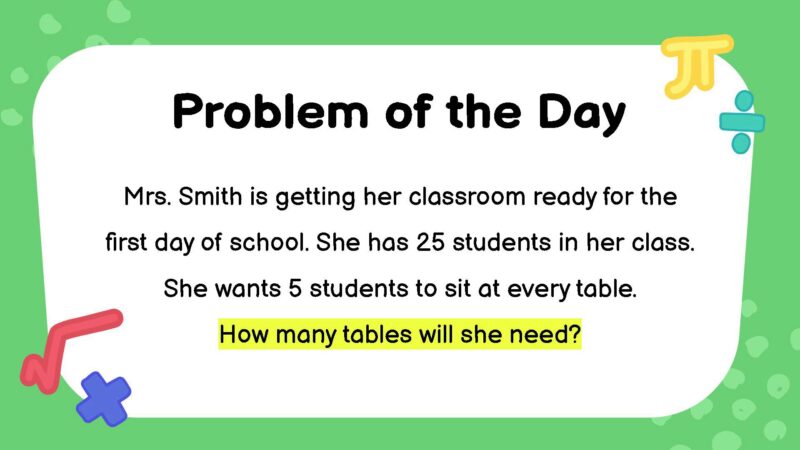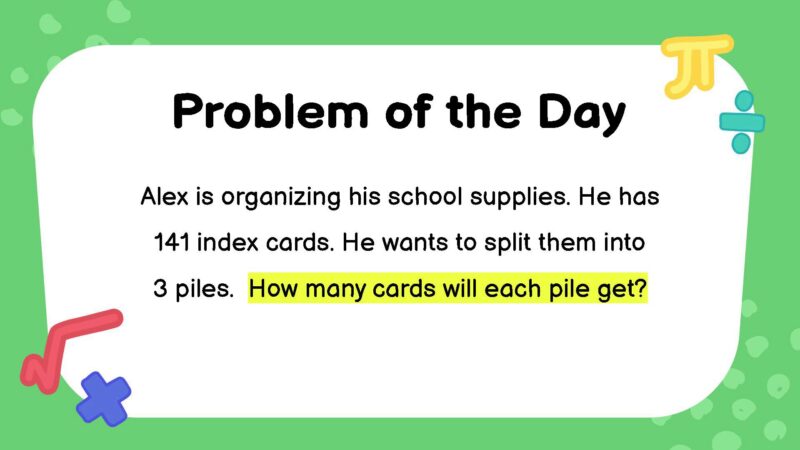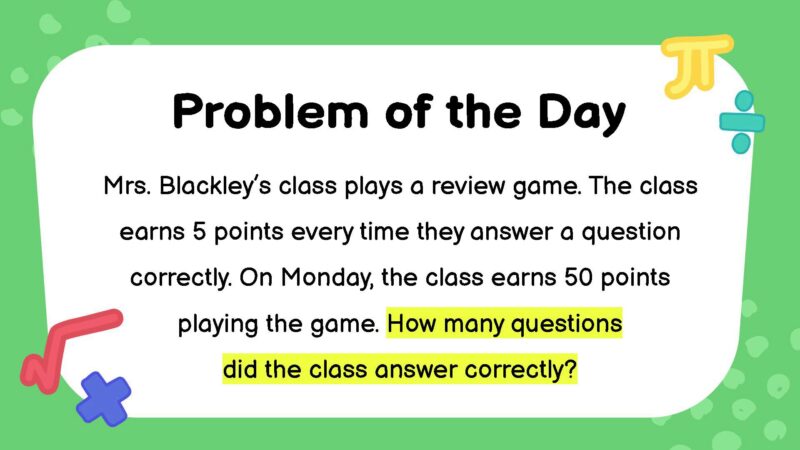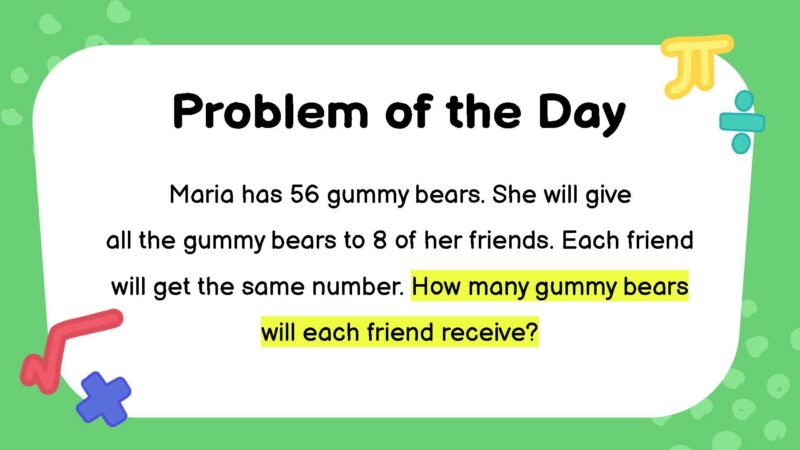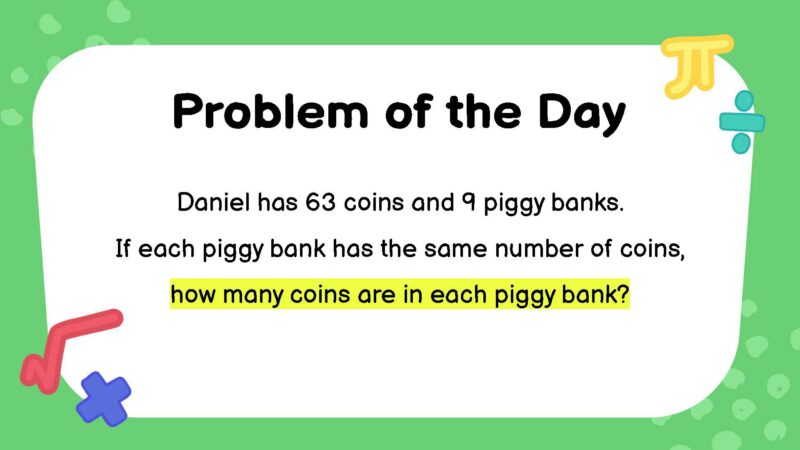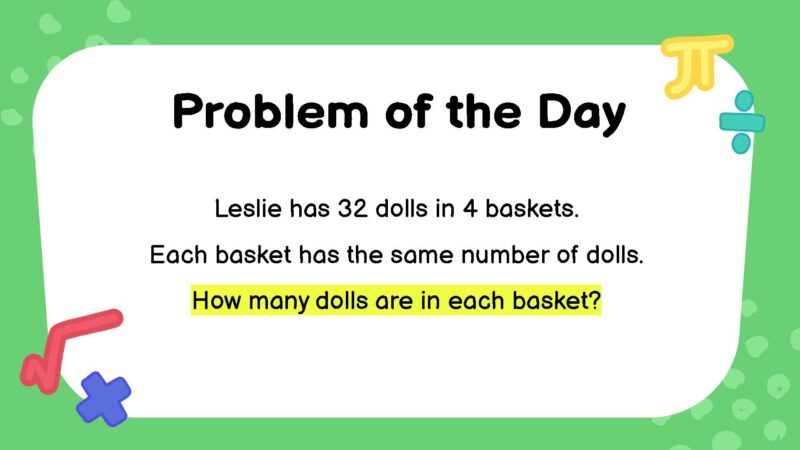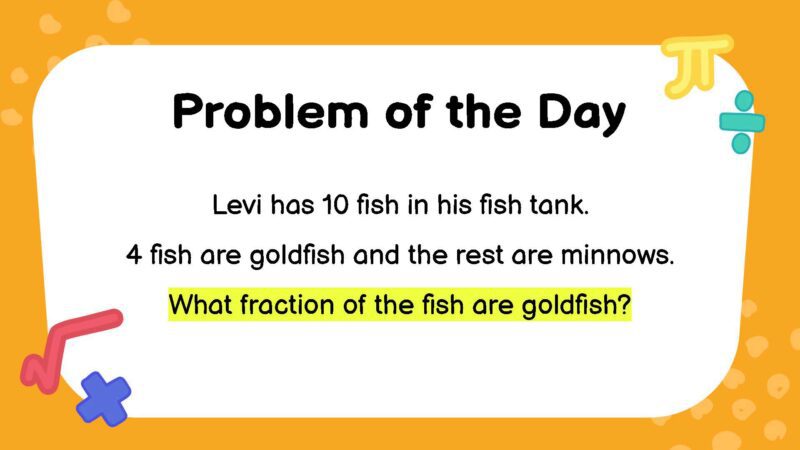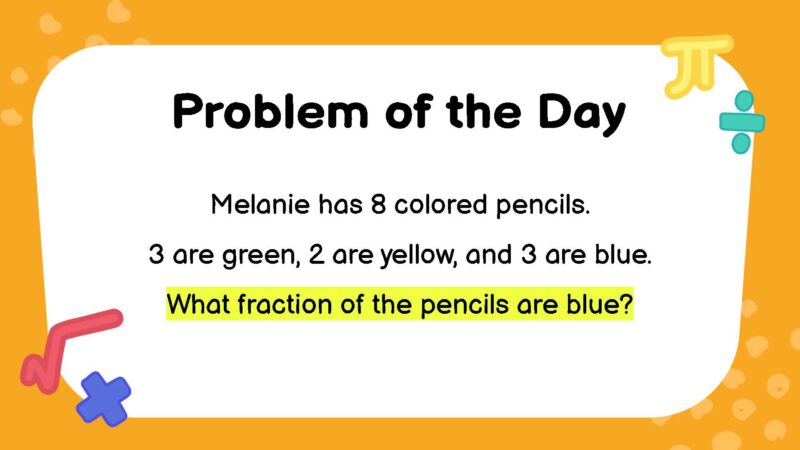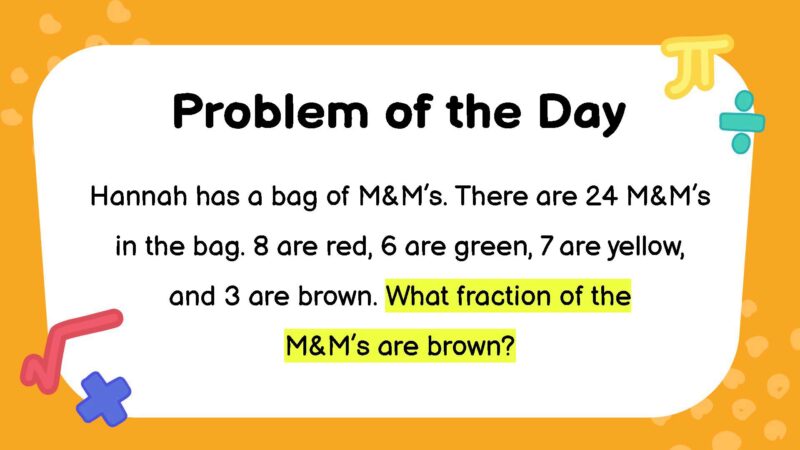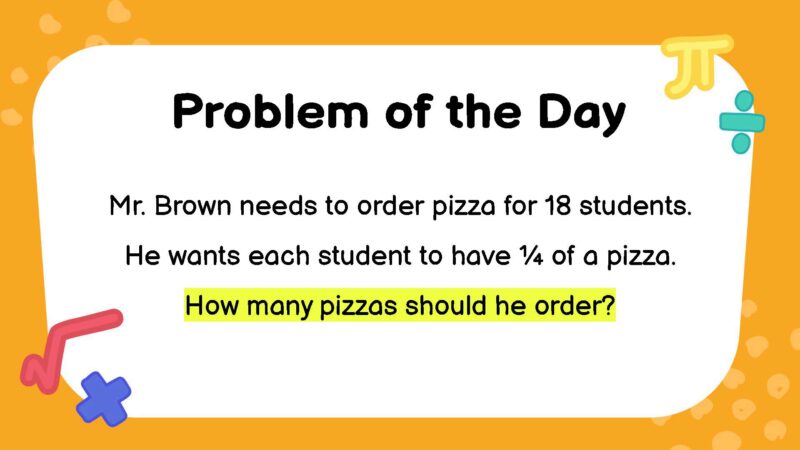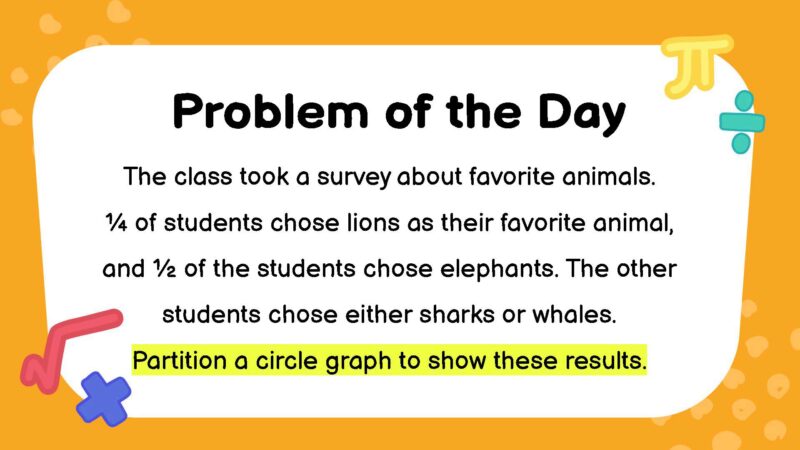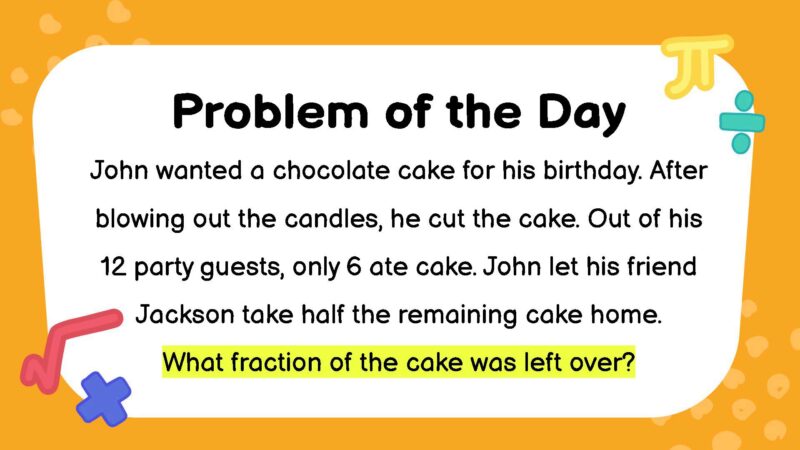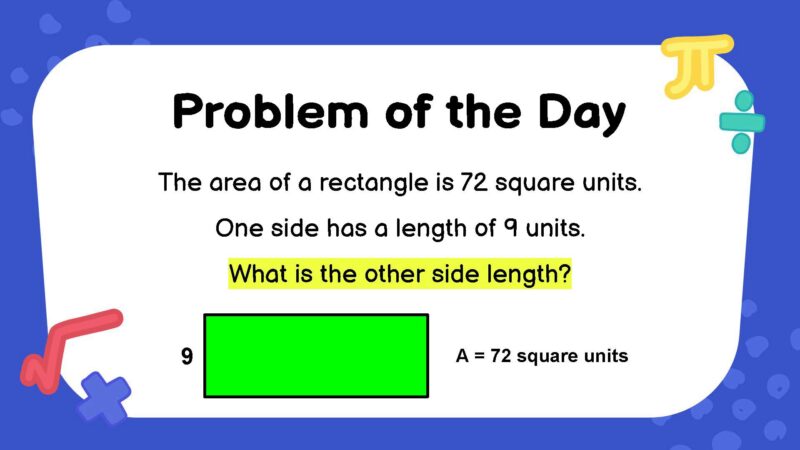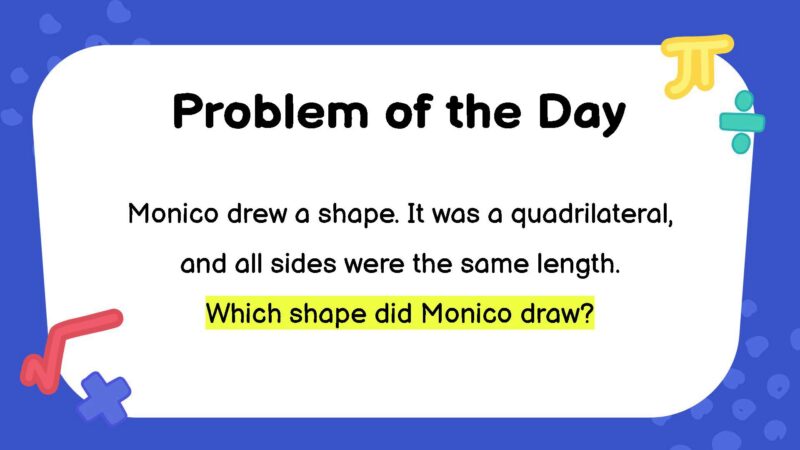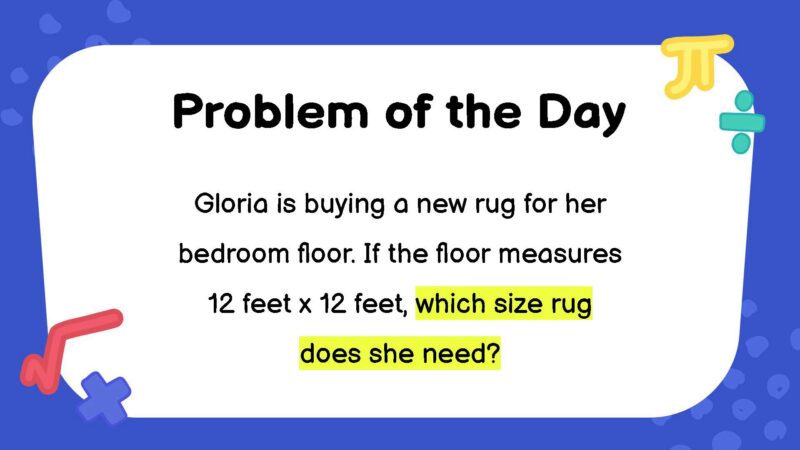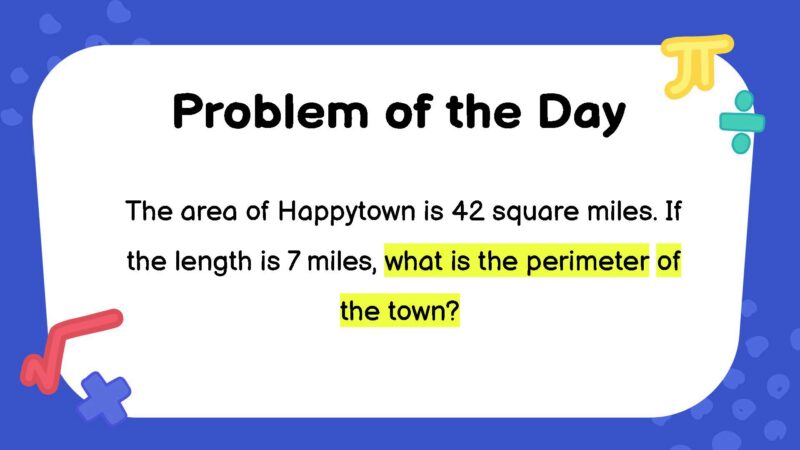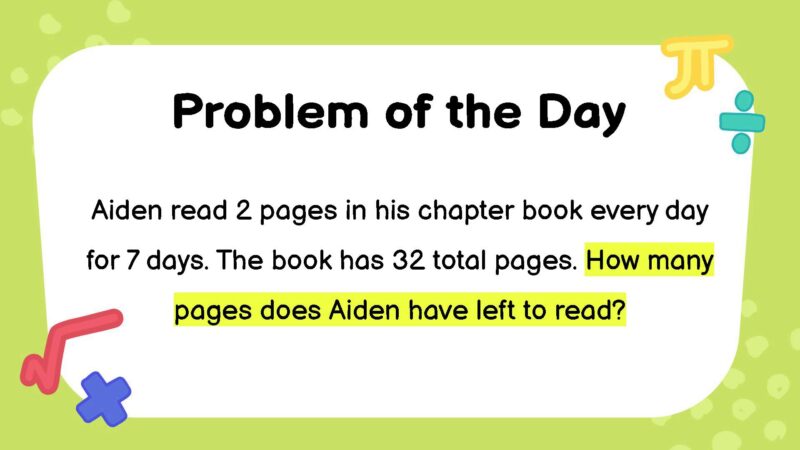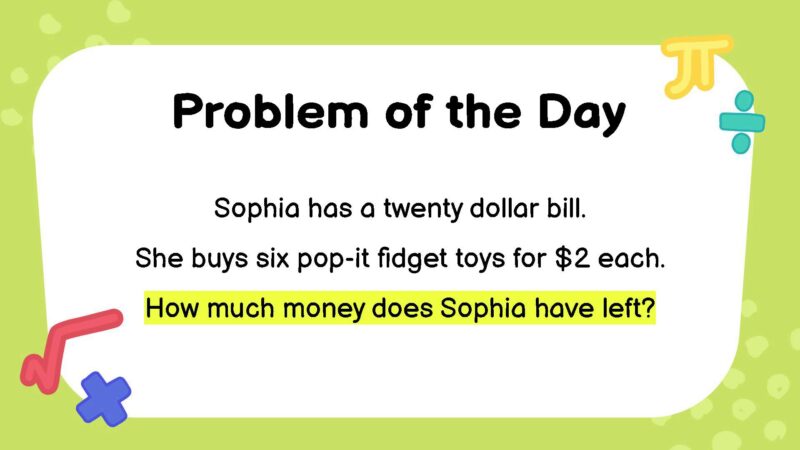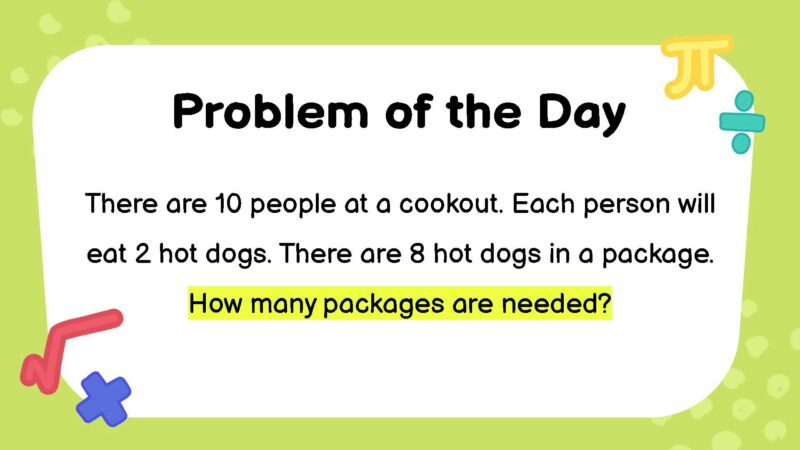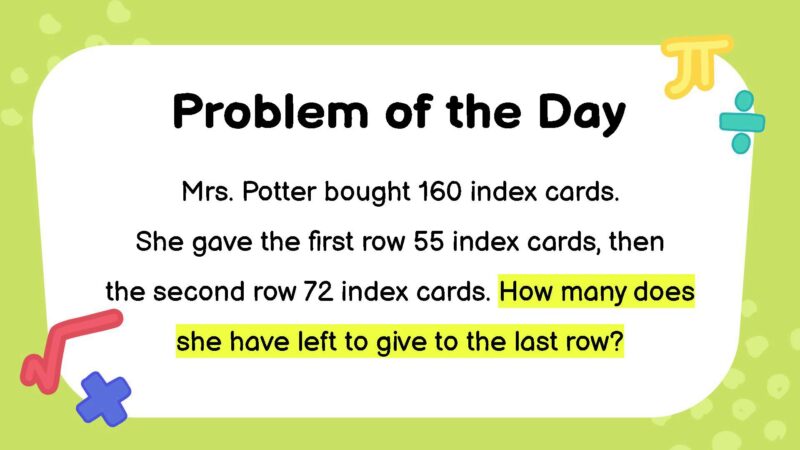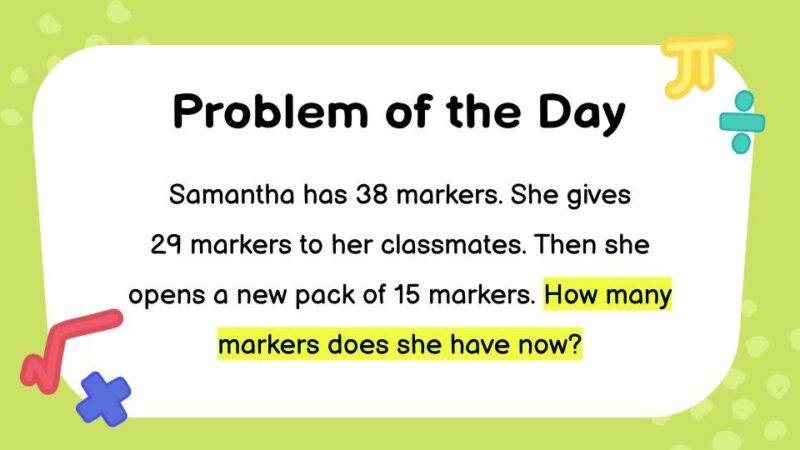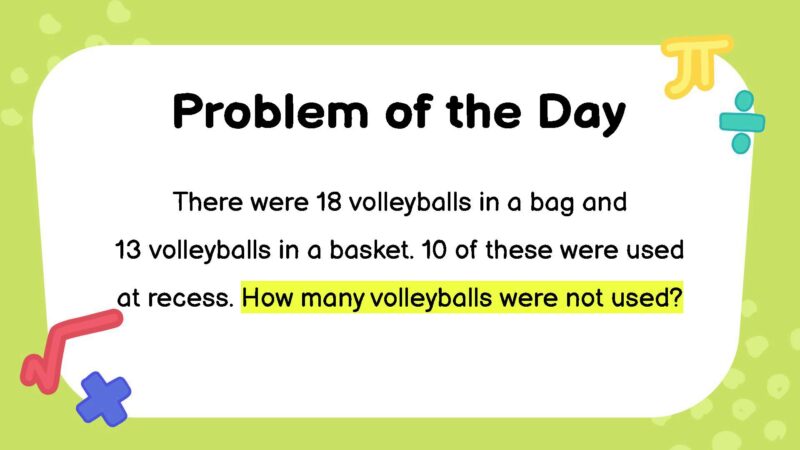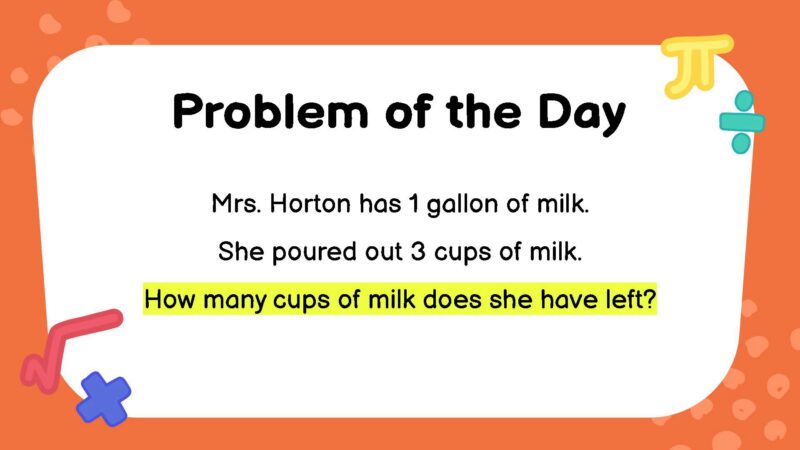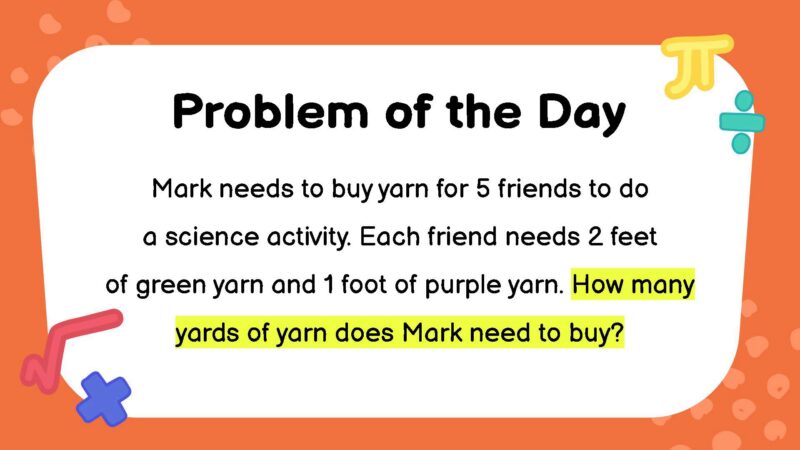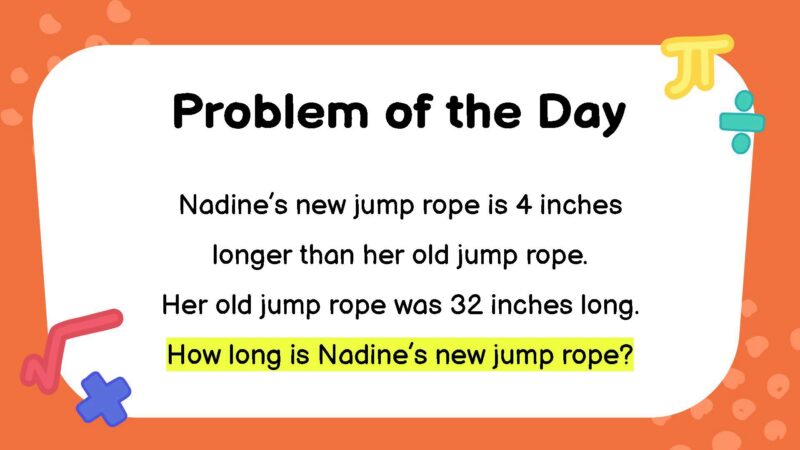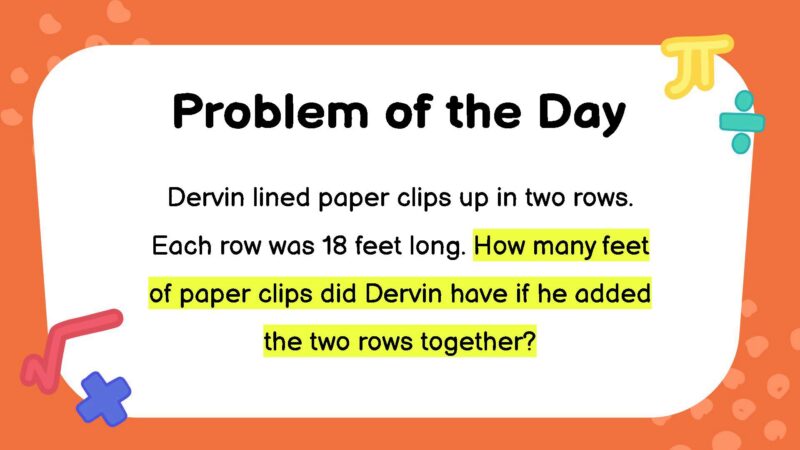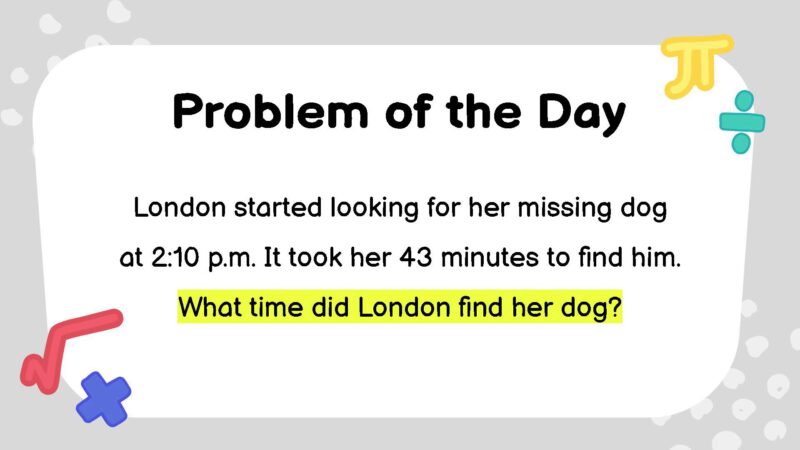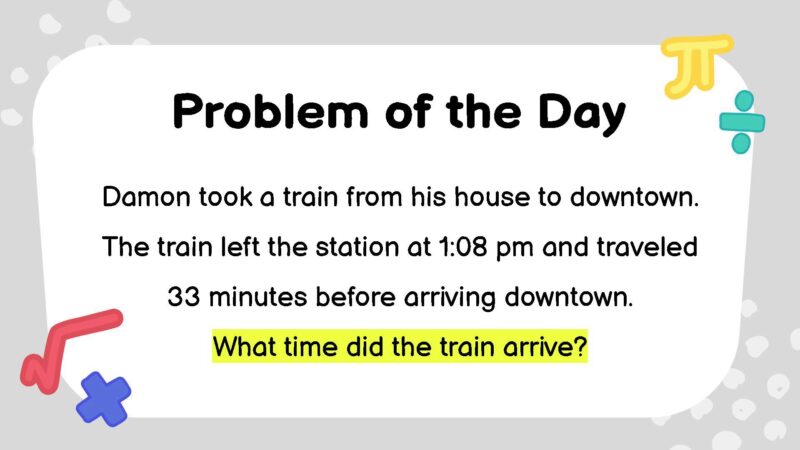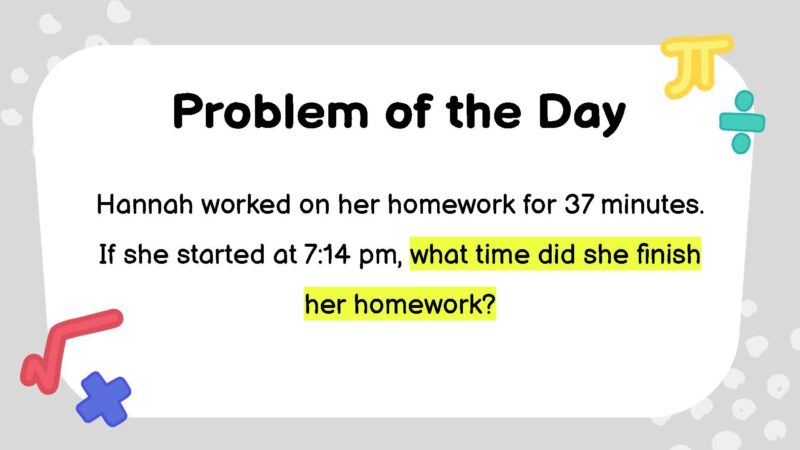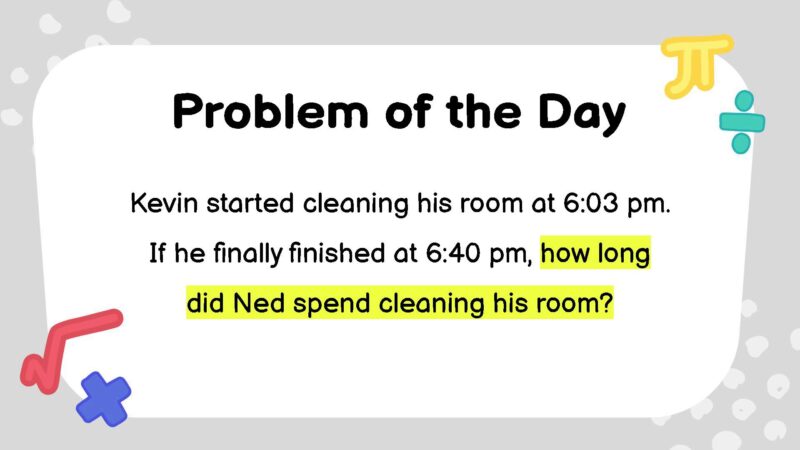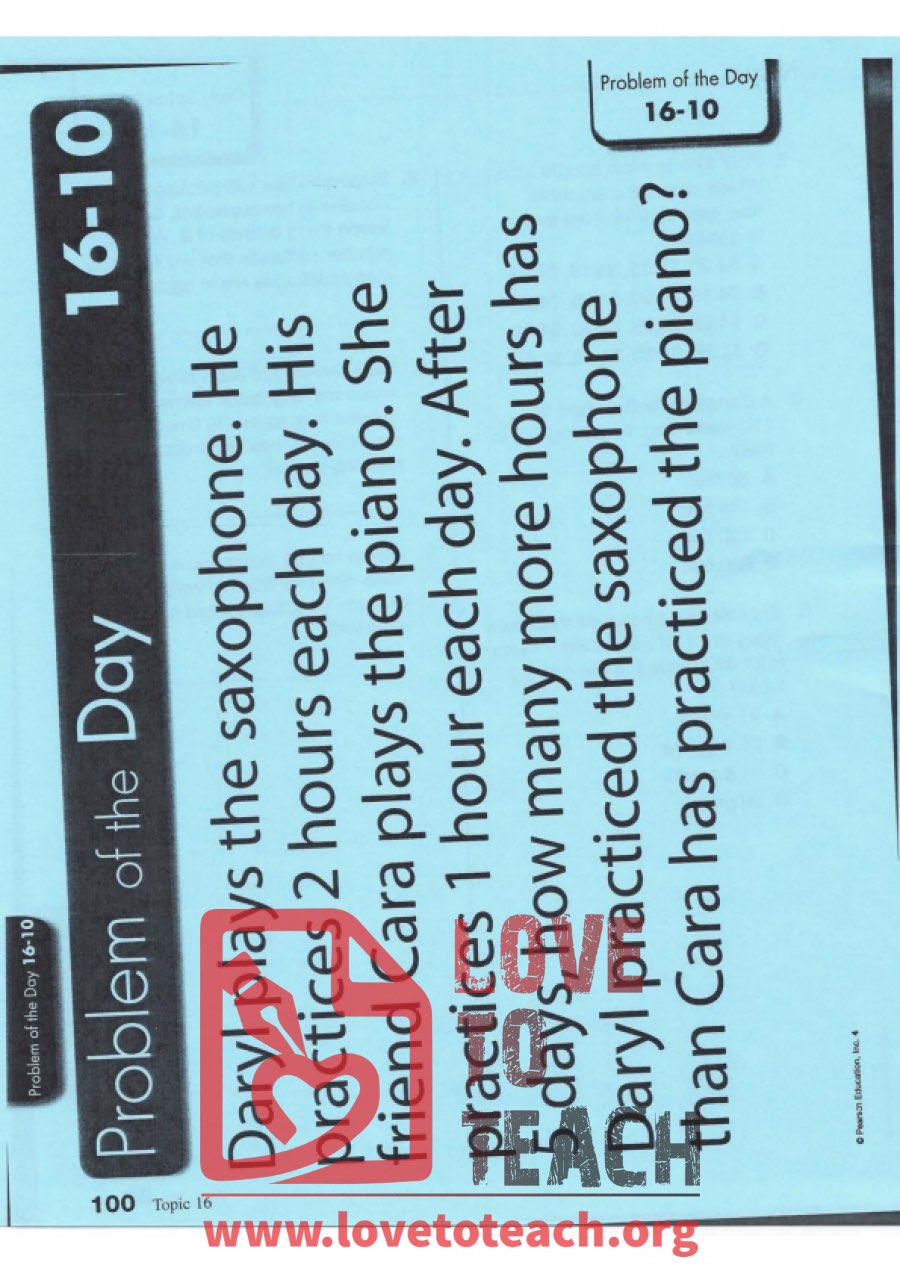Confession: It was my first year teaching and one month before the state test, I realized that I had failed to expose my students to enough word problems for them to be successful and confident with them. I was so caught up in the pacing guide and using the math textbook that I failed to make the math real world and situational for my students. Big mistake on my part and I had to spend the next month doubling down on word problems to make up for it.
Since that first year, I have learned a lot and started introducing word problems of the day as part of my math review or mini-lessons. On this post, I am sharing a free word problem of the day starter pack for you to use the first 20 days of school! This free word problem starter pack for 4th and 5th grade will set you on the right path of regular word problem practice and you won’t make the same mistake I did!
I touched on this a bit already but here are some more benefits of using a word problem of the day routine in your classroom:
- Continually exposes your students to word problems in a variety of contexts and with a variety of operations.
- When you use skill-based sets, you can ensure you only expose your students to word problems with skills they have been taught.
- Regular practice with word problem will lead to greater student success and, more importantly, confidence.
- Word problems will be a normal part of instruction and not seen as difficult or hard by students.
About the Word Problem of the Day Starter Pack
What skills are covered?
There are two versions, labeled Set A and Set B.
Set A has problems for addition and subtraction with 4-digit numbers and basic multiplication and division problems. There are also five multi-step problems. This set is ideal for the beginning of 4th grade (or the beginning of 5th graders who struggle with math).
Set B has problems for addition and subtraction with 6-digit numbers and multi-digit multiplication and division (multiplying by 1-digit only and dividing with 1-digit divisors). There are also five multi-step problems. This set is ideal for the beginning of 5th grade.
About the Format
Each set is available in three formats.
One problem per page format: This format works well for projecting the problems via a smartboard or printing them out to place at a math center.
One problem per page with student workspace: This format works well for giving each student a word problem daily. There is ample space for the students to organize and show their work.
One week per page: This format works well for paper-saving classrooms. All of the word problems for the week are on one page.
Using Review Skills to Begin the Year
I use the first month of school to really set the expectations and model for the students what I expect when they are solving word problems (read more about how we show the love with word problems here).
And it is so important that when teaching expectations and modeling a process, you use review skills that the students are already familiar with and have achieved mastery with. It is incredibly difficulty to try and teach students how you want them to solve a word problem using a math skill that they have not mastered yet. It will frustrate them and take away from the focus.
For that reason, I use these word problem of the day starter packs that contain skills from the previous grade level. This allows students to focus on the routine of solving a word problem daily and the process you want them to take before, during, and after solving a word problem.
Word Problem of the Day Routine
Speaking of the process, here is a brief run-down of how I use word problem of the day:
- I read the word problem and tell the students to focus on what is happening in the word problem.
- I ask for volunteers to reread the word problem and this time we focus on what the word problem is asking us.
- I ask 1-2 volunteers to retell the word problem in their own words.
- As a class, we restate the question into a sentence with a blank for the answer (this really ensures we know what the question is asking us).
- I give the students 1-2 minutes of private think time to think about how they will solve the problem.
- The students then get another 3-5 minutes of independent time to solve the problem. As the students are solving the problem, I monitor their understanding, ask guiding questions, and look for examples to share.
- We share what we think the answer is, how we got the answer, how we know it is correct, and the we plug it into our sentence (from step 4) and see if it makes sense.
The entire process takes about 15 minutes but is so valuable…and it does speed up as the year goes on and you can eliminate some of the steps.
How do I get the FREE word problem of the day starter pack?
Just put your email address in the box below and the starter packs (both Set A and Set B) will be sent to your inbox!
FREE Word Problem of the Day Packs
Join my email list to get the Word Problem of the Day Starter Packs for FREE! If you are already on my email list, you can sign up again for this freebie without getting duplicate emails. 🙂
Where can I buy more word problem of the day packs to continue this?
Once you finish with the starter packs, I have grade level sets available for purchase so you can continue your word problem of the day routine all year. The bundles include three main sets with three sets inside of the main sets for a total of 180 word problems. And the best parts are that the third set of each main set contains multi-step problems AND the sets are skill-based so you can ensure your students are only seeing word problems for skills you have taught. You can also mix and match the sets as you please.
We know that word problems are often a struggle for students. My first year in the classroom, when my students sat down to do the complex, open-ended part of our state assessment in February, I had a gut-wrenching feeling that I hadn’t prepared them. We did some word problems within each of our units. But, those word problems weren’t very complex. And, students always knew exactly what to expect because it was exactly what we were practicing. On that day, I realized it wasn’t enough and I made changes immediately. As in, we started a new routine the next week. I began using a word problem of the day and haven’t looked back. Every single year since, no matter what grade I’m teaching, we do a daily word problem. It’s made a huge difference for my students.
Spiral Review with Word Problem of the Day
One of my biggest motivations for doing a word problem of the day is that it gives students a spiral review of the standards. When students are only working on a specific skill in word problems at a specific time, i.e. during each unit of study, they know what skill to look for. It takes some of the analyzation out of it. Students don’t have to truly make sense of the problem. By moving through various problems at different times, students truly don’t know what to expect. Their focus turns to what the problem is asking and they have to use the information presented to develop a plan for solving. This unexpected practice is critical for building strong problem solvers.
Spiraling the standards also gives students ongoing exposure and practice with each standard. This helps them connect that practice to what they already know and help build the synapses needed for long-term memory. Repeated, ongoing practice is key for many students to truly master something and have it become part of their long term memory. I also like when new skills are presented in this way, though it’s not intentional. Students get an opportunity to try applying what they already know using their problem solving skills to tackle something new. It’s fascinating, and reinforcing, to see students successful with new, not formally presented skills. Our focus is then on their thinking and strategy use.
Rigorous Test Prep
As I mentioned, it was upon seeing my students working on the state test that I realized our previous word problem work was not rigorous enough. Students are expected to solve complex word problems using several standards and skills at one time. The state assessment gives several multi-step word problems plus the in-depth performance task that asks students to apply what they know. They need repeated practice with complex multi-step word problems with various contexts. While my daily practice is not to the level of the performance task, it does give students opportunities to use different strategies to solve. It gives them practice making sense of complex problems. Our word problem of the day routine gives students the time to talk about math and their choices in solving problems.
Math Talk
Another huge motivation for our daily problem solving routine is our math talk. During our word problem routine we focus on making sense of the problem, using models, writing equations, and ensuring we’re answering the question that is asked. I scaffold students through the work, focusing on my expectations and our problem solving steps. After that, it doesn’t look the same every day. Because the problem content spirals, our routine changes. Sometimes, we work through the problem together immediately. Most often, though, students complete it on their own. Afterwards, they share their thinking. Sometimes, it’s with a partner. At other times, it’s with a small group. We always bring it back together whole group to talk about the equations identified and strategies used to solve. I also use this time to address any misconceptions and common mistakes. Making sense of the problem and using successful models and equations are the most important components of our daily problem solving routine.
Through our daily word problems, we spend a lot of time talking about the problem and students’ thinking. I explicitly teach and reinforce sentence stems that help guide students’ conversations with each other and for explaining their thinking. Justifying their answers and critiquing the work of others is complex work. Repeated daily practice and scaffolding gives all students an opportunity to engage in these conversations.
My Math Talk Posters are perfect for a classroom bulletin board display. You can get these 17 math talk sentence stems posters for free, in both colored and black and white versions, by filling out the chart below.
Newsletter
Sign up to receive your free Math Talk Sentence Stem posters! After confirming your email, you’ll receive the file and be signed up for my weekly newsletter.
Word Problem of the Day
I have year-long bundles of word problems for 1st through 3rd grades. I’ve used these story problems every day year after year as part of our daily problem solving routine. With 30 problems in each set, there’s an abundance of opportunities to practice. Some days we’re able to complete 2 or 3 problems. Most days, we complete just one. We spend 10-15 minutes on each complex problem since our focus is on so much more than just the answer. It’s important that our daily problem is complex and rigorous so that the focus is on making sense of the problem and students’ thinking around their models and strategies.
1st Grade Word Problems of the Day
Building successful problem solvers means intentional problem solving practice with even our youngest learners. My 1st Grade Word Problem of the Day sets start working at the most basic levels. Students focus on making sense of the problems, writing an equation, and using a given picture to help them solve for the unknown. Throughout their practice students work with a variety of word problems including part-part-whole and start-change-end problem types. They give ongoing practice with the range of addition and subtraction word problem types. Students complete bar models, part-part-whole tables, start-change-end tables, tens frames, and use models to help them make sense of addition and subtraction. You can take a closer look at my 1st Grade Story Problem set and download the free set perfect for the beginning of the year by clicking the images below.
2nd Grade Word Problems of the Day
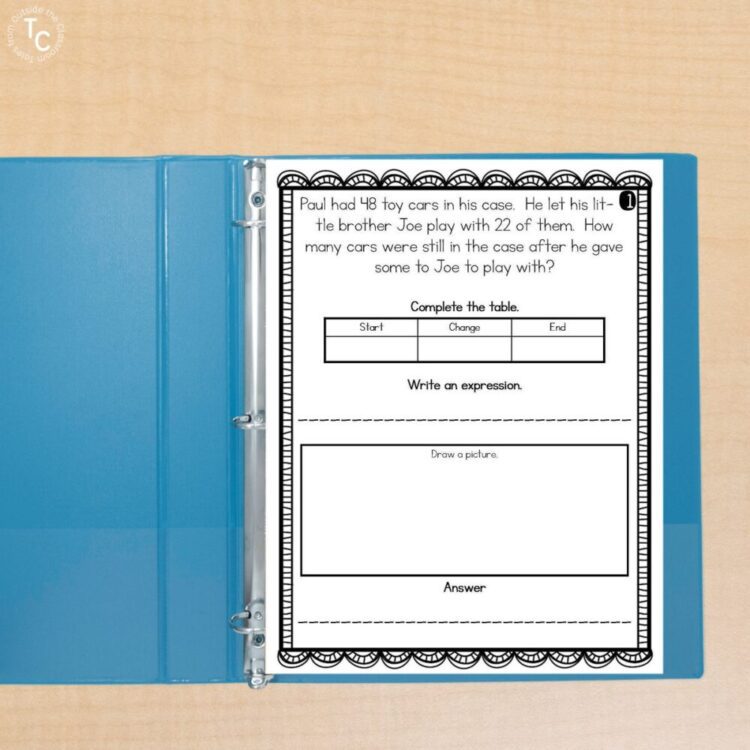
3rd Grade Word Problems of the Day
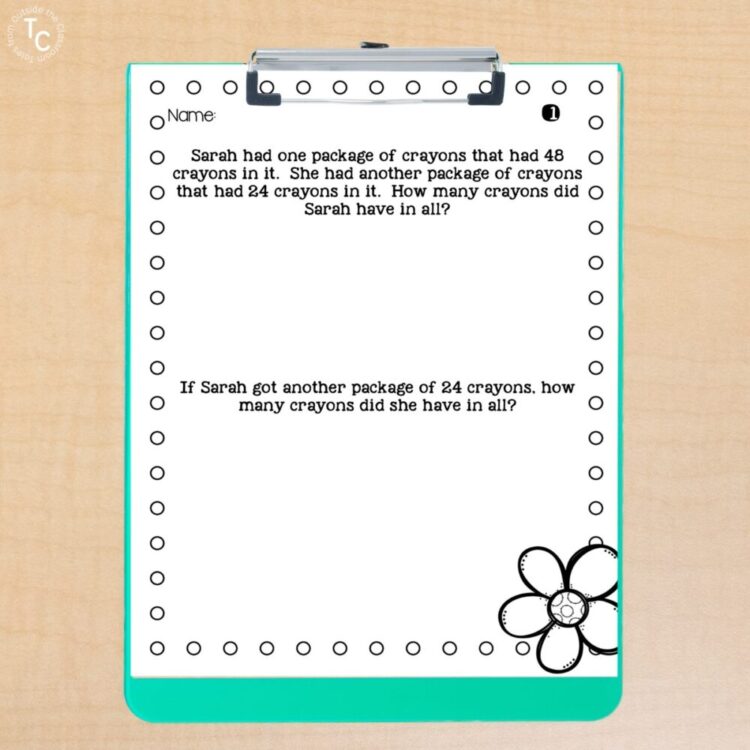
Our Word Problem of the Day, spiral review, and Number of the Day are absolute must supplements to our math block. Our daily problem solving practice gives students ongoing, rigorous practice with the standards and is a much-needed spiral review of the standards. You can read more about the specific steps in our daily routine in my 3 Reads Strategy post.
Opening your daily math lesson with a Math Word Problem of the Day is an excellent way to set the stage for learning. We all know that word problems are difficult for young learners to grasp, even when the mathematical operation portion of the problem is basic. Incorporate these third grade math word problems one day at a time at the start of your math block to build confidence, critical thinking skills, and a learning community. Students will get used to reading slowly for meaning, while also identifying key information. Encourage students to write out equations and draw pictures to explain their thinking, since this helps them see the light when they are stuck!
Topics covered include addition, subtraction, multiplication, division, mixed operation, fractions, area and perimeter, and measurement. All you need to do is post one of these third grade math word problems on your whiteboard or projector screen, then let kids take it from there.
Want this entire set of word problems in one easy document? Get your free PowerPoint bundle by submitting your email here.
1. Gage went shopping and bought 19 cupcakes, 18 apple pies, and 47 glazed donuts. How many items did he buy altogether?
2. A shelter is taking care of 384 cats. 176 more arrive. How many cats are in the shelter now?
3. Gabby has 42 books on her bookshelf. Her dad gives her 23 more for her birthday. How many books does Gabby have now?
4. There were 823 people attending a soccer game after 37 people left. How many people were at the game before the people left?
5. Mr. Washington has 44 pencils. He found 37 pencils inside of the cubbies and opened a new pack of 60 pencils. How many pencils does Mr. Washington have in all?
6. Jeff plays Minecraft. On Monday he played for 67 minutes. On Tuesday he played for 32 minutes, and on Wednesday he played for 43 minutes. How many total minutes did Jeff play during the week?
7. Smith Elementary School has 286 boys and 241 girls. What is the total number of students that attend Smith Elementary?
8. Ashley rides her bike to school every day. The ride from her house to her school takes 21 minutes. If she has already been biking for 17 minutes, how much longer does she have to ride before she arrives at school?
9. Jason baked 93 cookies to sell at the school bake sale. He plans to take home whatever cookies he doesn’t sell. If he sold 77 cookies, how many cookies will he take home?
10. A school collects money for T-shirts. Third graders collected $327. Fourth graders collected 138 fewer dollars. How much money did fourth graders collect?
11. Hayden has 610 stickers. There are 250 in a white box and some in a yellow box. How many are in the yellow box?
12. The table shows students’ class points. Which two students’ scores have a difference of 15 points?
13. Ms. Brady has 356 tomato plants. She sells 91 of the plants and gives 49 of the plants away. How many tomato plants does Ms. Brady have left?
14. David’s mom buys apples for his class. There are 5 rows of 4 green apples. There is 1 row of 4 red apples. Fill in the blanks to complete the expressions.
15. A box of chocolates has 14 rows. There are 6 pieces of chocolate in each row. How many pieces of chocolate are in the box?
16. Christy and Jan are playing a card game. Christy has 4 cards and Jan has 4 times as many cards. How many cards do they have together?
17. Emerson is in charge of collecting the basketballs at the end of gym class. There are 6 bins, and 7 basketballs can fit in each bin. How many basketballs are there if each bin is full?
18. Luz had two pages of homework. Each page had five problems on it. How many total problems did she have to complete?
19. Keyanna was drawing on scrap paper. She could fit seven drawings on each page. If she has three pieces of paper, how many drawings can she make?
20. A bakery sells one sugar cookie for $2.00. How much will a dozen sugar cookies cost?
21. Mrs. Smith is getting her classroom ready for the first day of school. She has 25 students in her class. She wants 5 students to sit at every table. How many tables will she need?
22. Alex is organizing his school supplies. He has 141 index cards. He wants to split them into 3 piles. How many cards will each pile get?
23. Mrs. Blackley’s class plays a review game. The class earns 5 points every time they answer a question correctly. On Monday, the class earns 50 points playing the game. How many questions did the class answer correctly?
24. Maria has 56 gummy bears. She will give all the gummy bears to 8 of her friends. Each friend will get the same number. How many gummy bears will each friend receive?
25. Daniel has 63 coins and 9 piggy banks. If each piggy bank has the same number of coins, how many coins are in each piggy bank?
26. Leslie has 32 dolls in 4 baskets. Each basket has the same number of dolls. How many dolls are in each basket?
27. Levi has 10 fish in his fish tank. 4 fish are goldfish and the rest are minnows. What fraction of the fish are goldfish?
28. Melanie has 8 colored pencils. 3 are green, 2 are yellow, and 3 are blue. What fraction of the pencils are blue?
29. Hannah has a bag of M&M’s. There are 24 M&M’s in the bag. 8 are red, 6 are green, 7 are yellow, and 3 are brown. What fraction of the M&M’s are brown?
30. Mr. Brown needs to order pizza for 18 students. He wants each student to have ¼ of a pizza. How many pizzas should he order?
31. The class took a survey about favorite animals. ¼ of students chose lions as their favorite animal, and ½ of the students chose elephants. The other students chose either sharks or whales. Partition a circle graph to show these results.
32. John wanted a chocolate cake for his birthday. After blowing out the candles, he cut the cake. Out of his 12 party guests, only 6 ate cake. John let his friend Jackson take half the remaining cake home. What fraction of the cake was left over?
33. The area of a rectangle is 72 square units. One side has a length of 9 units. What is the other side length?
34. Monico drew a shape. It was a quadrilateral, and all sides were the same length. Which shape did Monico draw?
35. Gloria is buying a new rug for her bedroom floor. If the floor measures 12 feet x 12 feet, which size rug does she need?
36. The area of Happytown is 42 square miles. If the length is 7 miles, what is the perimeter of the town?
37. Aiden read 2 pages in his chapter book every day for 7 days. The book has 32 total pages. How many pages does Aiden have left to read?
38. Sophia has a twenty dollar bill. She buys six pop-it fidget toys for $2 each. How much money does Sophia have left?
39. There are 10 people at a cookout. Each person will eat 2 hot dogs. There are 8 hot dogs in a package. How many packages are needed?
40. Mrs. Potter bought 160 index cards. She gave the first row 55 index cards, then the second row 72 index cards. How many does she have left to give to the last row?
41. Samantha has 38 markers. She gives 29 markers to her classmates. Then she opens a new pack of 15 markers. How many markers does she have now?
42. There were 18 volleyballs in a bag and 13 volleyballs in a basket. 10 of these were used at recess. How many volleyballs were not used?
43. Mrs. Horton has 1 gallon of milk. She poured out 3 cups of milk. How many cups of milk does she have left?
44. Mark needs to buy yarn for 5 friends to do a science activity. Each friend needs 2 feet of green yarn and 1 foot of purple yarn. How many yards of yarn does Mark need to buy?
45. Nadine’s new jump rope is 4 inches longer than her old jump rope. Her old jump rope was 32 inches long. How long is Nadine’s new jump rope?
46. Dervin lined paper clips up in two rows. Each row was 18 feet long. How many feet of paper clips did Dervin have if he added the two rows together?
47. London started looking for her missing dog at 2:10 pm. It took her 43 minutes to find him. What time did London find her dog?
48. Damon took a train from his house to downtown. The train left the station at 1:08 pm and traveled 33 minutes before arriving downtown. What time did the train arrive?
49. Hannah worked on her homework for 37 minutes. If she started at 7:14 pm, what time did she finish her homework?
50. Kevin started cleaning his room at 6:03 pm. If he finally finished at 6:40 pm, how long did Ned spend cleaning his room?
If you like these third grade math word problems, check out our third grade hub for even more resources.
Get a PPT version of these word problems.
Choose your grade level and you’ll jump to a page with hundreds of practice word problems, one for each day of the school year. (These pages are in-progress. We’ll keep adding more until we have 30 weeks/150 worksheets per grade level.)

Daily Word Problems
Kindergarten (Level K)
In Kindergarten, daily math word problem series will allow children to practice counting numbers to 20, comparing numbers (using more, most, fewest, etc.), adding and subtracting within 10, and identifying basic shapes.
Grade 1 (Level A)
Daily word problem worksheets for 1st grade students. Most problems require basic addition or subtraction. There are also occasional problems related to counting money and skip counting.
Grade 2 (Level B)
This page has 2nd grade daily math word problems. At this level, we have both single-step and multi-step problems. Single, double, and triple-digit addition and subtraction are frequently featured. Other skills include elapsed time, counting money, and repeated addition (multiplication).
Grade 3 (Level C)
In third grade, students will be presented with 2, 3, and 4-digit addition and subtraction problems, as well as questions involving basic multiplication, basic division, place value, counting money, tables & charts, and fractions.
Grade 4 (Level D)
In 4th grade, the daily word problems will consist of more multi-step math, covering operations with whole numbers, fractions, and decimals. There will also be questions related to place value, angles, graphs, and measurement conversions.
Grade 5 (Level E)
These 5th grade daily math worksheets continue to build on elementary math skills. Multi-step problems cover operations with whole numbers, as well as fractions and decimals. Understanding place value, calculating measurements, and reading charts and graphs are among the other skills covered in these worksheets.
Math Buzz
This is a different set of daily review worksheets, featuring a variety of math skills. Each day, students have 5 math questions to answer. Not all problems are word problems in this set.
Download

Skip this Video
Loading SlideShow in 5 Seconds..
Word Problem of the day PowerPoint Presentation
Download Presentation
Word Problem of the day
— — — — — — — — — — — — — — — — — — — — — — — — — — — E N D — — — — — — — — — — — — — — — — — — — — — — — — — — —
Presentation Transcript
-
Word Problem of the day There are 189 students in the band. The difference between the number of boys and the number of girls is 27. How many boys and girls each are in the band? G- R- A- S- S-
-
Model Notes: Factors «Factors» are the numbers you multiply together to get another number: Prime Factorization «Prime Factorization» is finding which prime numbers you need to multiply together to get the original number. Example 1 What are the prime factors of 12? It is best to start working from the smallest prime number, which is 2, so let’s check: 12 ÷ 2 = 6 But 6 is not a prime number, so we need to factor it further: 6 ÷ 2 = 3 And 3 is a prime number, so: 12 = 2 × 2 × 3 As you can see, every factoris a prime number, so the answer must be right — the prime factorisation of 12 is 2 × 2 × 3, which can also be written as 22 × 3
-
Example 2 What is the prime factorization of 147? Can we divide 147 evenly by 2? No, so we should try the next prime number, 3: 147 ÷ 3 = 49 Then we try factoring 49, and find that 7 is the smallest prime number that works: 49 ÷ 7 = 7 And that is as far as we need to go, because all the factors are prime numbers. 147 = 3 × 7 × 7 = 3 × 72
-
Another Method…. Factor Trees First, we did factorization by starting at the smallest prime and working upwards, but sometimes it is easier to break a number down into any factors you can, then work those factor down to primes. Example: What are the prime factors of 90? Break 90 into 9 × 10 ·The prime factors of 9 are 3 and 3 ·The prime factors of 10 are 2 and 5 So the prime factors of 90 are 3, 3, 2 and 5 Let’s draw it out visually into a tree:
-
Seatwork: http://www.mathgoodies.com/factors/factor_tree.asp Play the game 12 times. For each question, in your journal, draw out the factor trees and your solution. Remember to number each question. When done, show Ms. Koziak.
Daryl plays the saxophone. He practices 2 hours each day. His friend Cara plays the piano. She practices 1 hour each day. After 5 days, how many more hours has Daryl practices the saxophone than Cara has practiced the piano?
Download attachments:
-
Word Problem of the Day.pdf
(Download)
Word Problem of Day — 1 st Grade Start in February and continue through May.
Day 1 • 8 fish are swimming. Some fish join them. Now there are 17 fish. How many fish joined?
Day 2 • There are 10 bowling pins. Tina hits 4 of them. How many are left standing?
Day 3 • 2 golf balls are in the yellow basket. 4 golf balls are in the brown basket. There are 9 golf balls altogether. How many golf balls are in the green basket?
Day 4 • There are 6 tennis balls in one can. There are 5 in another can. How many tennis balls are there altogether?
Day 5 • There are 12 water bottles and 8 players. How many more bottles are there than players?
Day 6 • Mrs. Wood buys 15 flowers. She gives 8 to the children. How many flowers does she have left?
Day 7 • 13 players are on the field. 9 players are boys. How many players are girls?
Day 8 • Ann buys 5 red balls, 3 green balls, and 2 purple balls. How many balls did Ann buy in all?
Day 9 • The Tigers won 4 games in June. They won 3 games in July. They won 4 games in August. How many games did the Tigers win in all?
Day 10 • Some goggles are in the bag. Nate puts 6 more goggles in the bag. Now there are 10 goggles. How many goggles were in the bag before Nate put 6 more in?
Day 11 • Start with 9 blocks. Then add 7 more. How many blocks in all?
Day 12 • Bill has 5 puzzle piece. Jill has 3 more pieces than Bill. How many pieces does Jill have?
Day 13 • Hyun has 4 red blocks. Her mom gives her 7 blue blocks. How many blocks does Hyun have in all?
Day 14 • There are 5 green toy trucks and some yellow toy trucks. There are 13 toy trucks in all. How many yellow toy trucks are there?
Day 15 • Rosa had some gold stars. Dad gave her 6 more. Then she had 15 gold stars. How many gold stars did Rosa have to start with?
Day 16 • Sam has 3 more stickers than Jim has 10 stickers. How many stickers does Sam have?
Day 17 There are 7 red balloons and 5 yellow balloons at the party. How many balloons are there in all?
Day 18 • There are 13 peppers. There are 7 red peppers. The rest are green. How many are green?
Day 19 • Some ducks were on the lake. 4 ducks flew away. Now 8 ducks are left. How many ducks were in the lake to start with?
Day 20 • Robin has 3 fewer crackers than Nick has 10 crackers. How many crackers does Robin have?
Day 21 • Zoe has 13 buttons. She has 9 green buttons. The rest are yellow. How many yellow buttons are there?
Day 22 • Sophie has 3 fewer stamps than Mike has 9 stamps. How many stamps does Sophie have?
Day 23 • There were some toys on the table. Jaquavious put 2 toys away. Now there are 5 toys on the table. How many toys were on the table to start?
Day 24 • La. Toya had 12 pencils. She gave some away. She has 8 pencils left. How many pencils did La. Toya give away?
Day 25 • There were 17 flowers in a garden. Dan cut 8 flowers. How many flowers are left?
Day 26 • Tim has 5 toys. Jane has 2 toys and Sally has 4 toys. How many toys are there in all?
Day 27 • There are 2 blue balloons, some red balloons, and 4 yellow balloons at a party. There are 11 balloons in all. How many red balloons are there?
Day 28 • Jenna’s cookie jar had 5 cookies in it. She baked 12 more cookies. When they cooled, she added them to the cookie jar. What is the new total number of cookies in Jenna’s cookie jar?
Day 29 • Peter had some baseball cards. He gave 5 to Mike and then he had 10 left. How many cards did Peter have to begin with?
Day 30 • Josie had 20 erasers. She gave some to Mike and then she had 15 left. How many erasers did Josie give to Mike?
Day 31 • Dr. Jackson had some pieces of paper. Ms. Hubbard gave Dr. Jackson 6 more pieces of paper and then she had 15 in all. How many pieces of paper did Dr. Jackson have to begin with?
Day 32 • Dr. Wood had 6 tables. Mrs. Grace gave Dr. Wood some more tables and then she had 13 in all. How many tables did Mrs. Grace give Dr. Wood?
Day 33 • Mrs. Thornton had 7 toy cars. She gave three away. How many cars did Mrs. Thornton have left?
Day 34 • Mrs. Mc. Ghee had 5 post it notes. Mrs. Stewart gave her 3 more. How many post it notes did Mrs. Mc. Ghee have in all?
Day 35 • Mrs. Montgomery blew up 4 blue balloons and 5 red balloons for the Fall Festival. How many balloons did Mrs. Montgomery blow up?
Day 36 • 7 kids were on the bouncy thing. 2 more kids came into the bouncy thing. How many kids were on the bouncy thing?
Day 37 • A pet store had some goldfish in a tank. The store sold 8 goldfish, leaving 9 goldfish in the tank. How many goldfish were in the tank to start with?
Day 38 • Hibbitts had 20 shoes on the shelf. The store sold some shoes, leaving 12 shoes on the shelf. How many shoes did the store sell?
Day 39 • Some people got on the bus at the first stop. At the second stop 5 more people got on for a total of 12 passengers. How many people got on the bus at the first stop?
Day 40 • Dr. Mc. Cloud picked 7 flowers on Monday morning. In the afternoon she picked some more flowers. If Dr. Mc. Cloud picked 15 flowers in all, how many did she pick in the afternoon?
Day 41 • Mrs. Doig blew up 8 blue balloons for her son’s birthday party. 3 balloons popped. How many balloons were left?
Day 42 • Mrs. Walls gave me 3 pencils. Mr. Matt gave me some more pencils and then I had 5 pencils. How many pencils did Mr. Matt give me?
Day 43 • Mr. Bryant had some pennies. He gave 7 pennies to Mrs. Kemp. Now Mr. Bryant has 13 pennies. How many pennies did Mr. Bryant have to begin with?
Day 44 • Mr. Morman had 19 snow cones. He gave some snow cones to Dr. Beall. Now Mr. Morman has 10 snow cones. How many snow cones did he give to Dr. Beall?
Day 45 • The zookeeper fed some animals before the zoo opened. After the zoo opened he fed 7 more animals. If the zookeeper fed 11 animals in all, how many animals did he feed before the zoo opened?
Day 46 • Mrs. Lee read 10 pages of her book before lunch. After lunch she read some more. If Mrs. Lee read 19 pages in all, how many pages did she read after lunch?
Day 47 • Mrs. Tanner had 10 pages in her book to read. She read some in bed and then she still had 4 pages left to read. How many pages did she read in bed?
Day 48 • 3 pigs rolled in the mud. Some more pigs came and then there were 7 pigs rolling in the mud. How many more pigs came to roll in the mud?
Day 49 • Some shapes were in a box. Debra Brock put in 5 more shapes and then the box had 9 shapes. How many shapes were in the box to begin with?
Day 50 • Some cupcakes were on the table at a party. 10 cupcakes were eaten. 5 cupcakes were left on the table. How many cupcakes were on the table when the party began?
Day 51 • Mrs. Barnes bought some pencils for her school. One week later 7 pencils were missing. 13 pencils were left. How many pencils did Mrs. Barnes buy?
Day 52 • Mrs. Givins had some books. She donated 5 books to the school fair. Now Mrs. Givins has 6 books. How many books did Mrs. Givins have to begin with?
Day 53 • Some children were at the playground. At one o’clock 12 children went home for lunch. 6 children stayed at the playground. How many children were at the playground before one o’clock?
Day 54 • 15 cupcakes were on the table at a party. Mr. Grayson ate some. 3 cupcakes were left on the table. How many cupcakes were eaten?
Day 55 • Mrs. Franks bought 20 stickers for the treasure box. One week later some stickers were missing. 14 stickers were left in the treasure box. How many stickers were missing?
Day 56 • On Monday, Zelma Brock collected cans for recycling. On Tuesday she collected 10 more cans for a total of 19 cans. How many cans did Zelma collect on Monday?
Day 57 • On Friday, Mr. Ward bought some presents for his family. On Saturday he bought 7 more presents. If Mr. Ward bought 15 presents in all, how many presents did he buy Friday?
Day 58 • Dr. Short ate 12 grapes at snack time and more grapes at lunch time. If Dr. Short ate 20 grapes in all, how many grapes did he eat at lunch time?
Day 59 • A bowl had some apples in it. Katie put in 2 more and then there were 5 apples in the bowl. How many apples were in the bowl to begin with?
Day 60 • 10 kids went on a roller coaster ride. Some kids got out and 8 kids stayed on. How many kids got out?
Ms. C. Kelly’s Classroom
April 7: Problem #90
April 8: Problem #89
April 9: Problem #91
April 10: Problem #91
April 13: Problem #93
April 14: Problem #94
April 15: Problem #95
April 16: Problem #96
April 17: Problem #97
April 20: Problem #98
April 21: Problem #63
April 22: Problem #64
April 23: Problem #65
April 27: Problem #66
April 29: Problem #67
April 29: Problem #68
April 30: Problem #69
May 1: Problem #70
May 4: Problem #71
May 5: Problem #132
May 6: Problem #133
May 7: Problem #134
May 8: Problem #135
May 11: Problem #136
May 12: Problem #137
May 13: Problem #138
May 14: Problem #139
May 15: Problem #140
May 18: Problem #116
May 19: Problem #117
May 20: Problem #119
May 21: Problem #120
May 22: Problem #121
May 26: Problem #123
May 27: Problem #124
May 28: Problem #126
May 29: Problem #127
Page updated
Google Sites
Report abuse

